BEYOND THE MASK





Dr. Petramay Attard Cortis MD DESA MMED (Dundee)
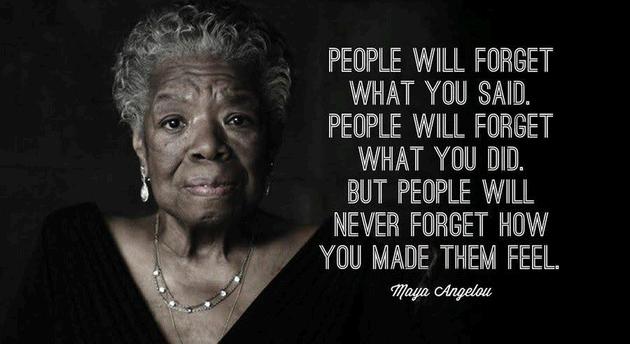
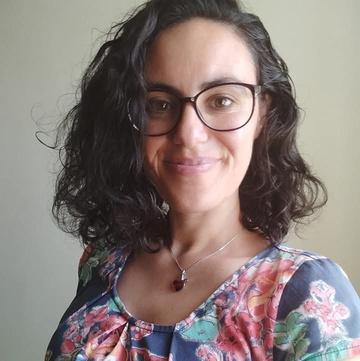
This quote fits the message I would like to convey to all AAIM’s members at the end of my term as Education and Events Coordinator perfectly.
It is my sincere hope that we, i.e., the AAIM Committee, and the various Education and Events Subcommittee members, have made the past 30 months eventful!
The social meetings, including Christmas, summer, and team-building occasions, were designed to encourage the creation of a local anaesthesiology and intensive care community, that is engaged and enthusiastic.
The educational “focuses” on paediatrics, obstetrics, and the high-risk patient, aimed to stimulate our members and our wider multidisciplinary teams in feeling educated, empowered, and enlightened.
Personally, it was a pleasure to observe this group of colleagues demonstrate eagerness and excitement to learn, to improve, and to get to know and support each other.
The AAIM Committee tried very hard to ensure that attendance at each event was encouraged and equitable.
So, although you may not remember all we said, and all we did, I hope you will remember how we wanted to make you feel. ��
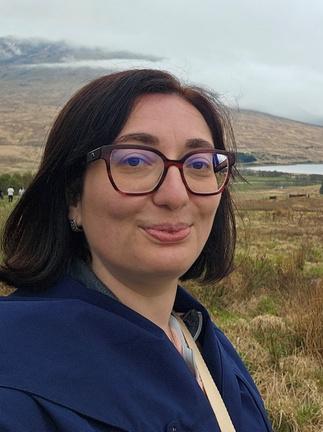
Dr Stephanie Mifsud
BSC MD DESAIC MSC
On behalf of the AAIM Committee, I would like to express our sincere thanks for the continued support and encouraging feedback we’ve received from our members. Your engagement motivates us to keep moving forward. It is a pleasure to share this latest edition of the AAIM newsletter, highlighting a number of exciting developments and collaborative initiatives. The editorial team has once again worked hard to deliver an engaging fourth issue, filled with news, updates, and valuable content relevant to our anaesthesia and intensive care community.
In the past ten months, the AAIM has organised several well-received events, including: the AAIM stand at the Science in the City on the 27th of September, the second ANATAS and Summer event on the 28th September, the 2024 AGM, Christmas event, our international conference on “The High-risk Patient: Anaesthesia, Intensive Care and Pain Perspectives” on the 21st– 22nd February 2025, and AGM 2025 Additionally, during Euroanaesthesia 2025 in Lisbon, Portugal, the AAIM committee and several AAIM members, namely, Adrienne, Maria and Sara, were busy with manning our booth in the NASC village. Furthermore, Dr. Anne Marie Camilleri Podesta, and Dr. Stephanie Mifsud also represented the AAIM in numerous ESAIC meetings in their respective roles of AAIM President and Secretary.
Our commitment to patient safety and quality care also remains central. AAIM has formally endorsed both the updated Helsinki Declaration on Patient Safety in Anaesthesiology 2.0 and the Santa Cruz Declaration on Patient Blood Management, during Euroanaesthesia 25, reflecting our alignment with international best practices. In addition to organising its own successful courses and events, AAIM is proud to announce that it will be organising the local edition of the ESAIC’s Advanced Patient Safety Course (APSC) on the 30th and 31st of October 2025 This highly regarded course brings international expertise to our doorstep and represents an excellent opportunity for professional development in patient safety. (More details on page 35)
The AAIM continues to actively engage with both local and global partners in advancing anaesthesia and intensive care in Malta. We are also pleased to share that AAIM has established a dual membership agreement with the European Society of Intensive Care Medicine (ESICM). Through this partnership, AAIM members can now benefit from a reduced ESICM membership rate of €180 (regular €230). This collaboration aims to strengthen our connection to the wider European intensive care community, while expanding access to ESICM’s educational resources, training programmes, and networking opportunities. We encourage members to take full advantage of these exciting developments and stay engaged with the growing opportunities AAIM continues to offer.
In this edition of the AAIM eNewsletter, you'll find a comprehensive recap of our recent events and commitments, as well as a look ahead at future projects, educational events, and opportunities for professional development. We’re also proud to feature a rich selection of member-contributed articles, including: a voluntary trip to Kenya, a trainee’s experience abroad, an interview with the new Chair of the National Anaesthesiologists Societies Committee (NASC), insight into an EDIC and ESAIC examiner’s mind, insights from ISICEM 2025, an introduction to the ESAIC Safer Care to Save Lives Ambassador’s Programme, and worthy projects like Call 112 Fibrillu and more.… A heartfelt thank you to Anne Marie, Petramay, Maria, Adrienne, Martina G., Yanika, Velitchka, Stephen, and Kristina E. for their excellent contributions. A special note of appreciation goes once again to Martina G. for her continued support, expertise, and dedication in designing the layout of this eNewsletter.
In conclusion, I would like to thank each and every one of you for your continued engagement and active participation as AAIM members throughout 2025. We truly hope you enjoy this issue and find value in what we’ve prepared for you.
Happy reading!
Stephanie AAIM Secretary
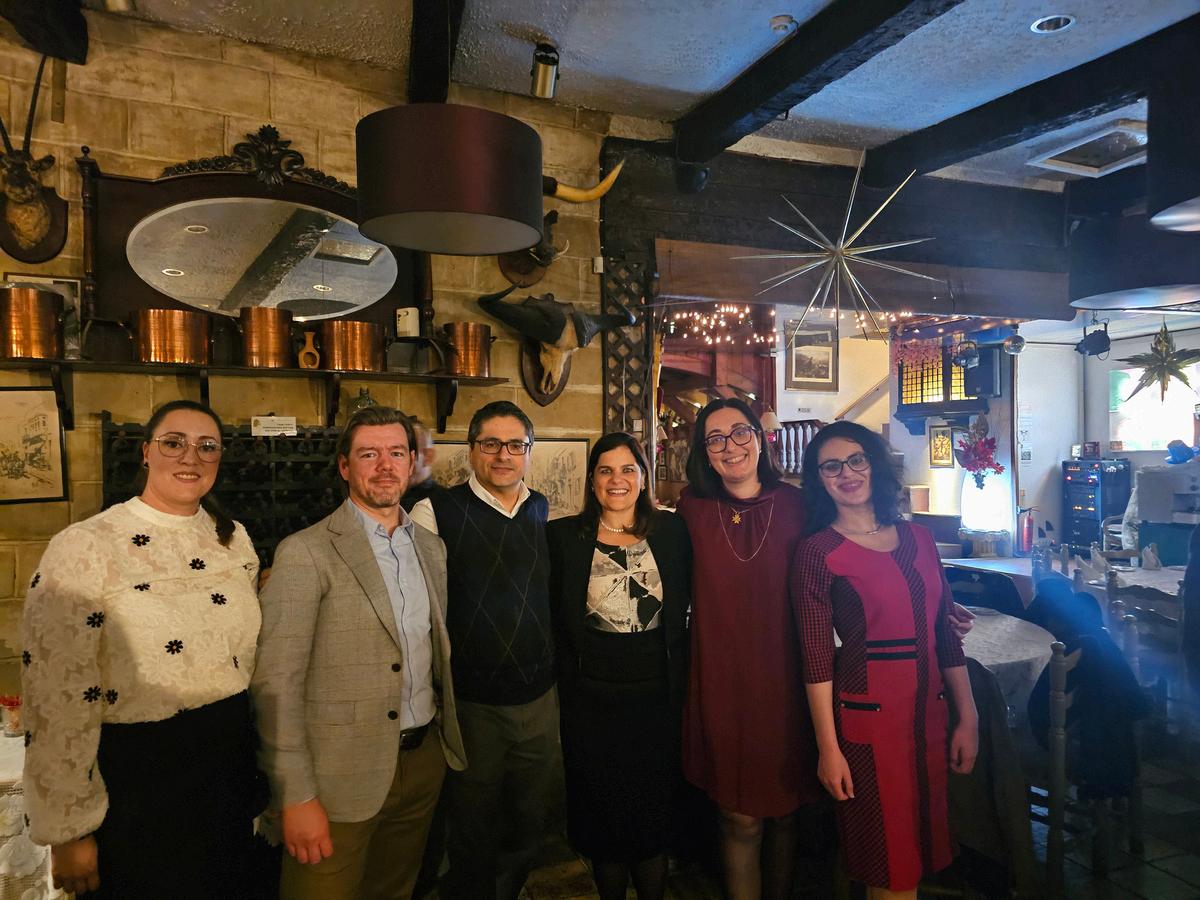
A dedicated team of 5 anaesthetic trainees, 3 nurses, and a consultant ran an engaging stand at the Science in the City event in Valletta on the 2th September 2024. Their goal was to educate the public, dispel fears and misconceptions about anaesthesia, and offer hands-on experiences to build understanding and confidence. Hundreds of visitors of all ages took part in interactive demonstrations, airway skill workshops, anaesthesia simulations, and lively discussions. The team also highlighted the critical role of anaesthesia in surgery, intensive care, labour, and pain clinics. It was a highly successful and busy weekend of public outreach, and we extend a big thank you to both the public for their enthusiasm and our amazing team for their hard work and dedication!
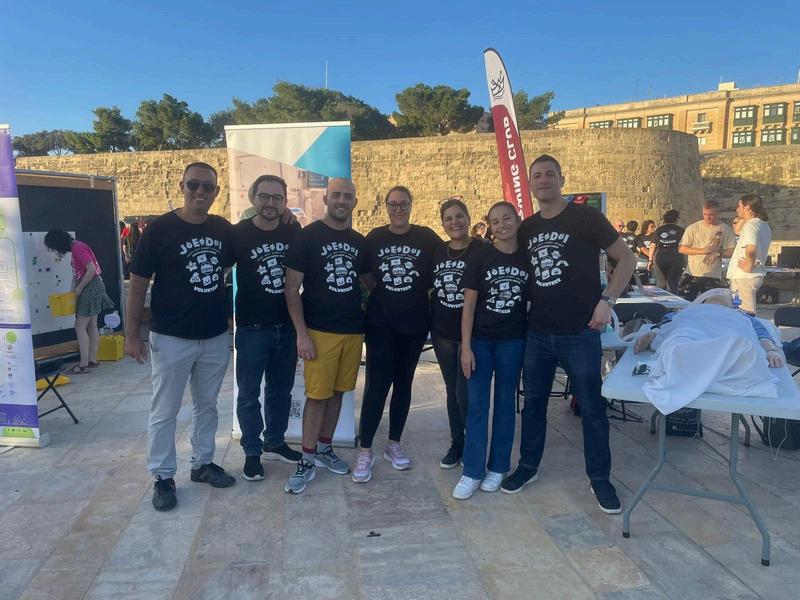
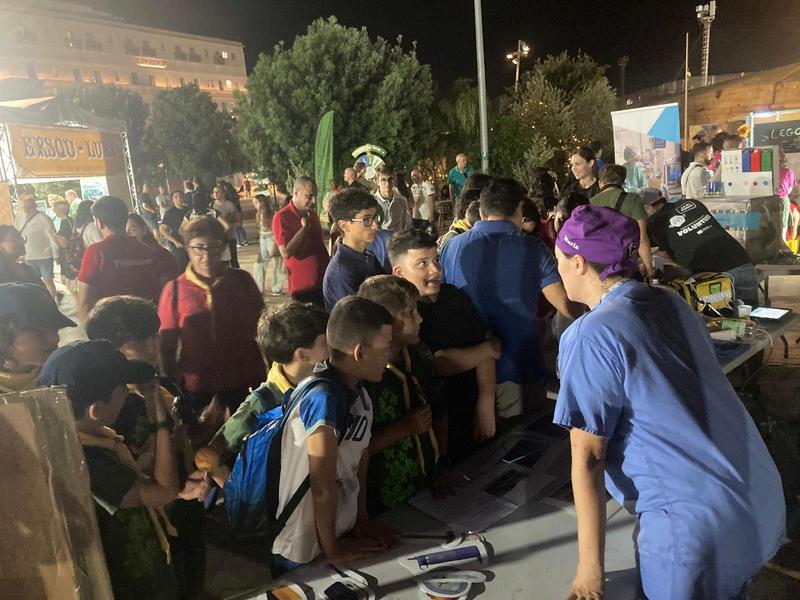
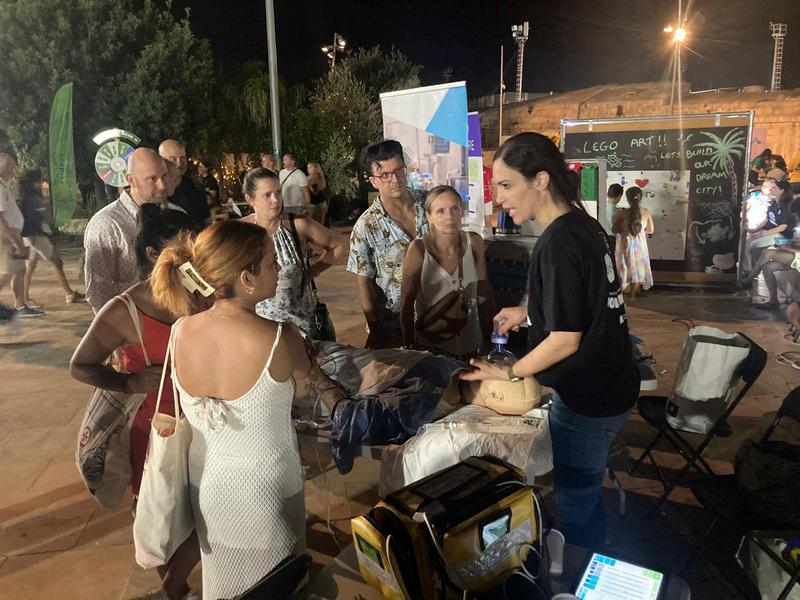
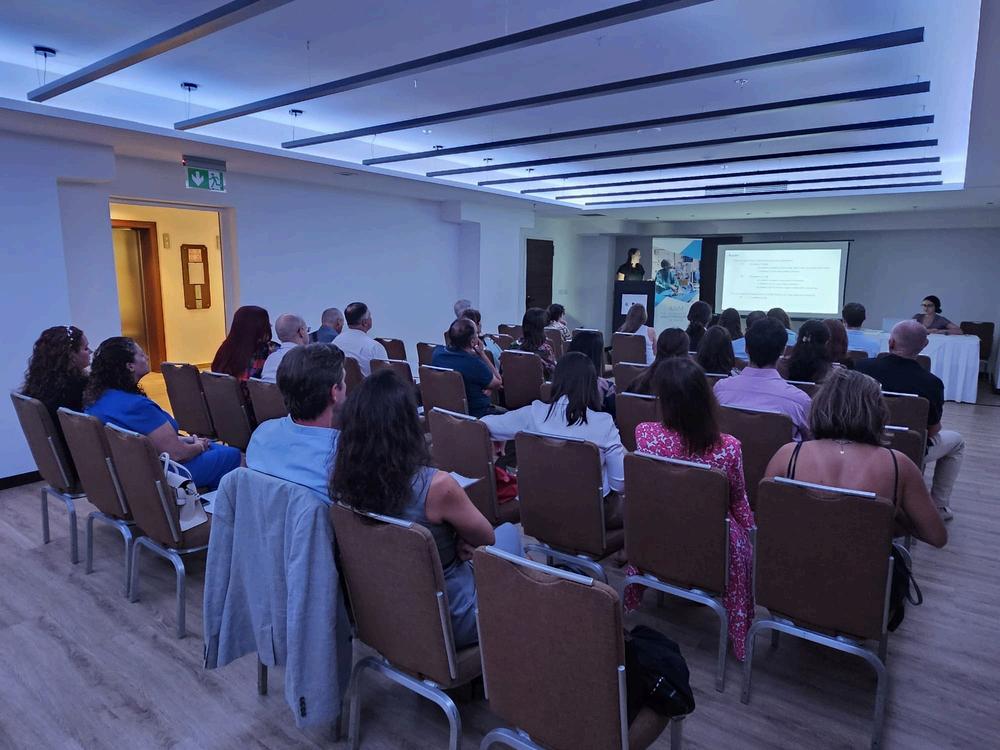
The attendees following the trainees’ presentations attentively.
Held on 28th September 2024, the 2nd ANATAS celebrated the academic achievements of Malta’s anaesthetic trainees, aiming to enhance their presentation skills and formally recognise top submissions.
Nine trainees presented their high-quality work to an audience of colleagues, specialists, and retired AAIM members. Judges Dr Daniel Farrugia, Dr Carmel Abela, and Dr David Spiteri awarded educational grants to the top three:
�� First Prize – Drs Rebecca Galea & Martina Gerada: Anaesthetists: basic perceptions of the general public in Malta
�� Second Prize – Drs Martina Gerada & Gianluca Fava: Recall of Neuraxial Procedural Risks for Caesarean Section
�� Third Prize – Drs Nigel Schembri & Emma Hunter: Use of patient-controlled analgesia with morphine following Caesarean sections and patient perceptions at Mater Dei Hospital
The event, hosted by Dr. Petramay Attard Cortis with the support of the AAIM Committee, was followed by the AAIM’s End of Summer gathering—an enjoyable evening of socializing, generously subsidised by the AAIM.
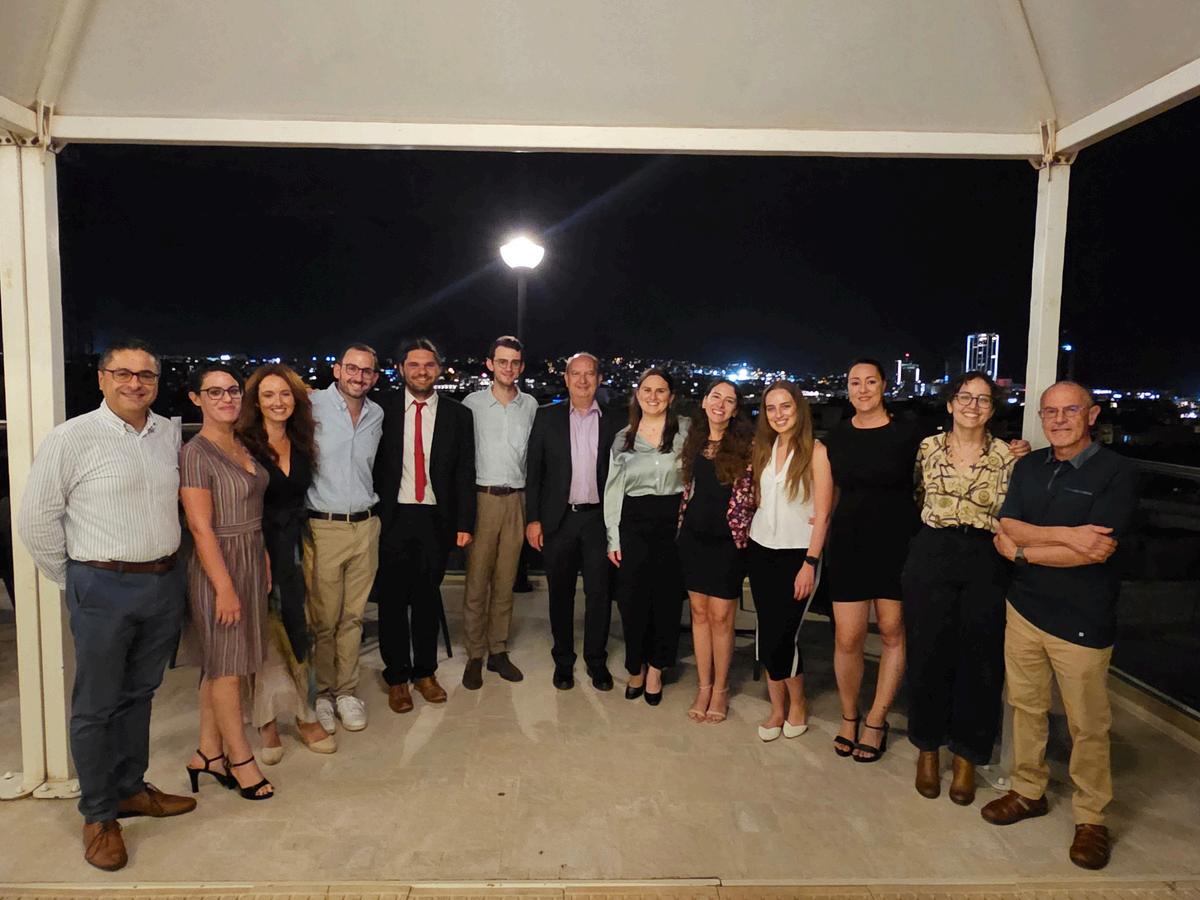
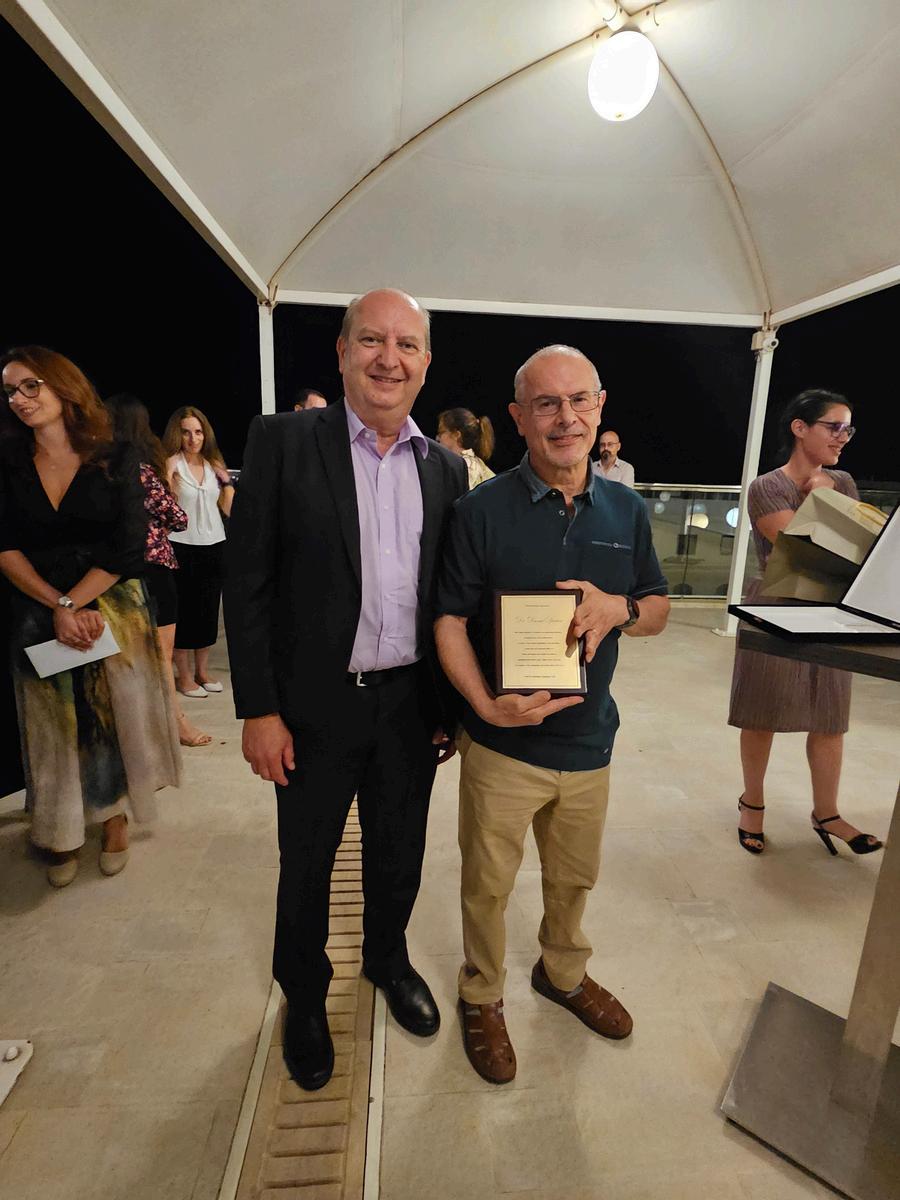
To mark World Anaesthesia Day on 16th October 2024, the AAIM organised a series of activities. A stand was set up in the main foyer of Mater Dei Hospital, featuring an interactive presentation, various anaesthesia related equipment and mannequins for airway practice and was manned by the AAIM committee. This provided a great opportunity for the AAIM committee and members to engage with the public, answer questions, and address any misconceptions about our profession. Additionally, a selection of cakes was brought to the anaesthesia department to celebrate the occasion together.
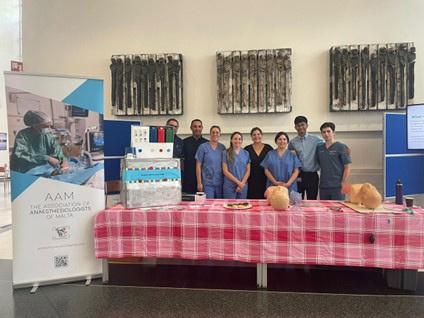
The AAIM held its AGM on Monday, 18th November 2024, with a good attendance and active participation from its members. Committee members presented highlights of the past year, with reports from the President, Vice-President, Secretary, Treasurer, Education and Events Coordinator, and Trainee Representative showcasing the association’s achievements.
A major milestone in 2024 was the association’s rebranding from the Association of Anaesthesiologists of Malta to the Association of Anaesthesiologists and Intensivists of Malta (AAIM) — a change that better reflects the intensive care aspect of the profession and aligns with similar European associations like ESAIC. The motion to adopt the new name and update the statute was proposed and unanimously approved. Members also voted on a new logo to symbolize this transition, while preserving the old logo as a historical emblem. During the meeting Dr. Maria Spiteri Zammit was introduced as the incoming Trainee Representative 2024-2025, whilst thanking Dr. Adrienne Zerafa Simler, the outgoing Trainee Representative. Finally the committee shared the association’s vision and plans for the coming year 2025.
The AAIM 2024 Christmas Event was held on the 4th December 2024 at Ta’ Marija Restaurant in Mosta, bringing together members for a festive evening of celebration. The event offered a wonderful opportunity for colleagues to relax, enjoy good food, and strengthen connections outside the clinical setting. With a lively atmosphere, delicious traditional Maltese dishes, and plenty of laughter, the evening was a memorable way to close the year and celebrate the hard work and achievements of the AAIM community.
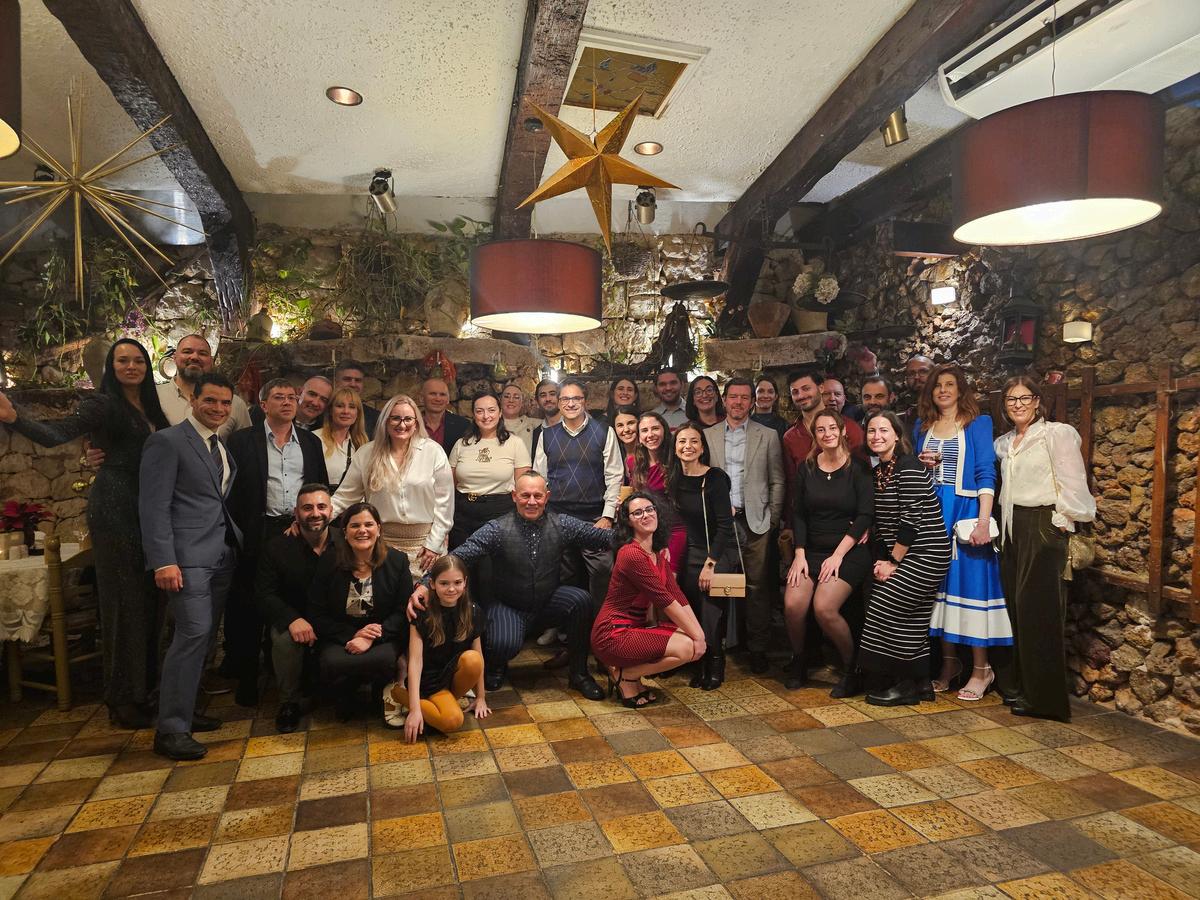
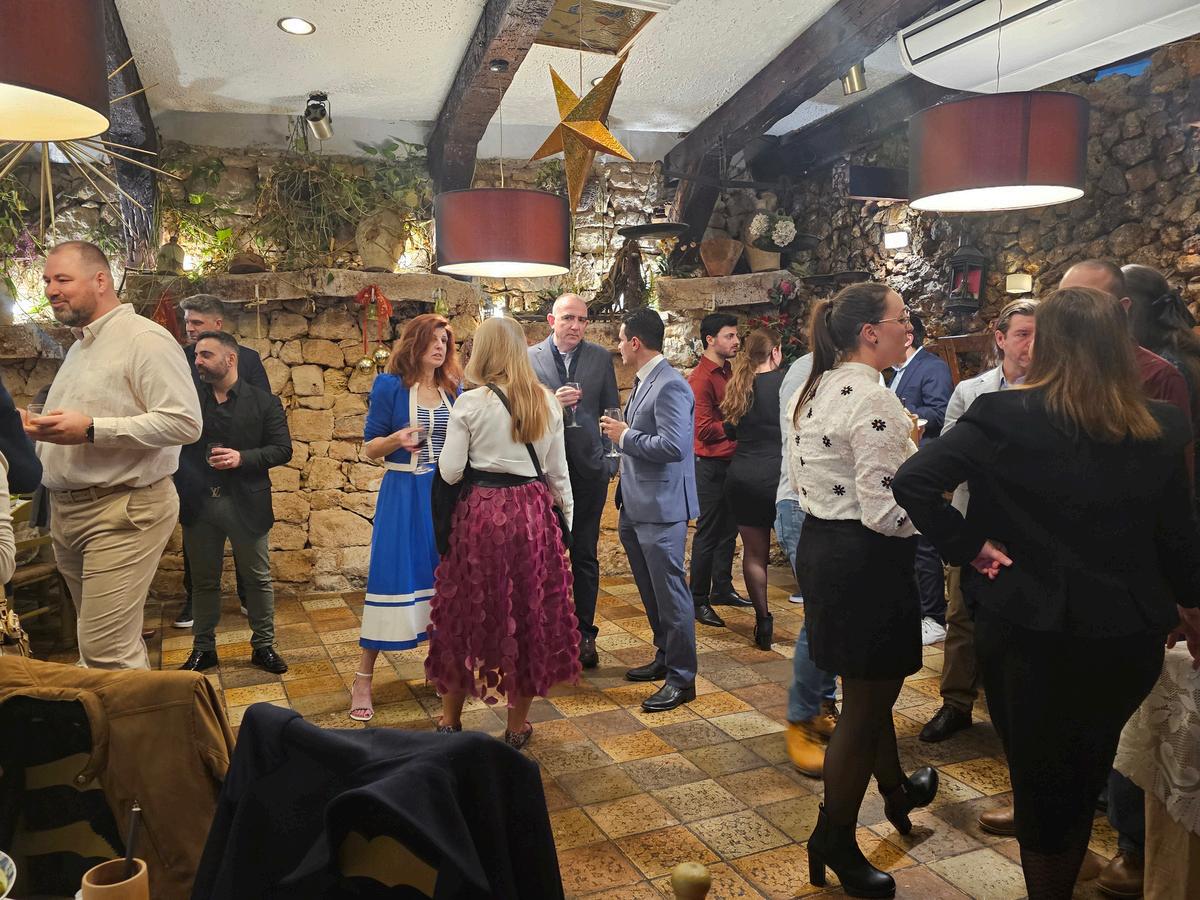
Almost €1 million in funds were awarded this year to voluntary organisations (VOs) across Malta and Gozo to support the implementation of 85 new projects aimed at benefiting local communities during an event on the 18th February 2025. These funds were distributed under two key funding programmes: the Voluntary Organisations Project Scheme (VOPS) and the Small Initiatives Support Scheme (SIS), both managed by the Malta Council for the Voluntary Sector (MCVS) within the Ministry for Inclusion and the Voluntary Sector (MIV). Among the successful applicants, the Association of Anaesthesiologists and Intensivists of Malta (AAIM) was awarded a SIS grant, which will be used to fund the upcoming ESAIC APSC course, helping to further advance professional development and training within the field of anaesthesia and intensive care.
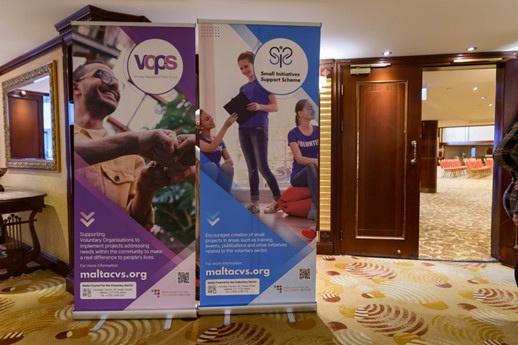
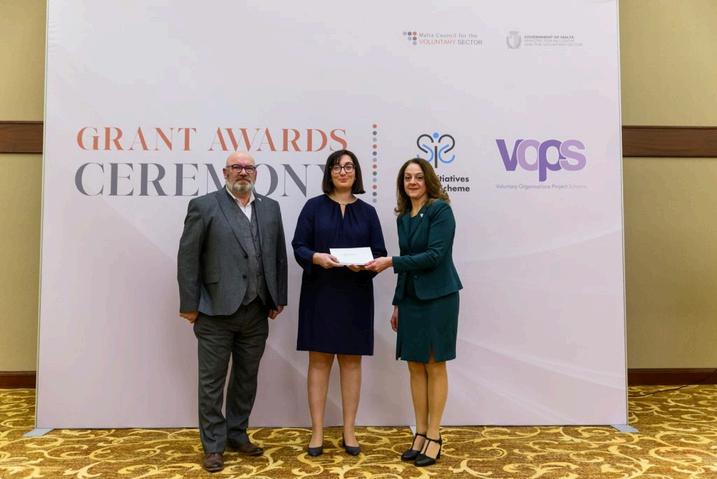
The Association of Anaesthesiologists and Intensivists of Malta (AAIM) successfully hosted its international conference, The High-Risk Patient: Anaesthesia, Intensive Care, and Pain Perspectives, on 21st–22nd February 2025 at the Malta Marriott Resort & Spa, St. Julian's. The event brought together over 200 delegates, including local and international anaesthesiologists, trainees, nurses, and other healthcare professionals. Over two days, participants engaged in expert-led sessions, interactive discussions, and valuable knowledge sharing — with the conference receiving outstanding feedback from attendees. More detailed information on page 41.
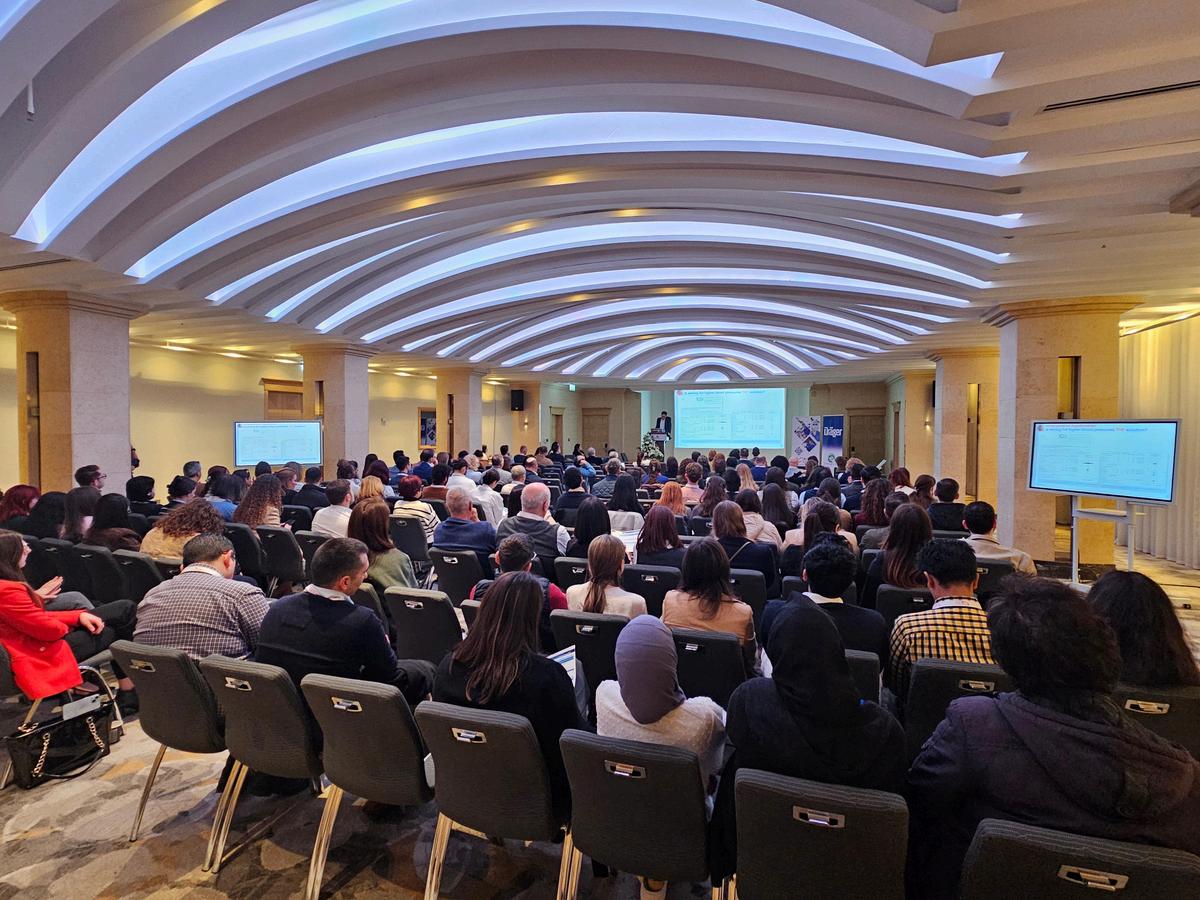
The AAIM Annual General Meeting (AGM) 2025 was held on the 13th March, bringing together members to review the past year’s achievements, discuss future plans, and shape the direction of the association. It also provided an opportunity for members to engage with the committee, share ideas, and contribute to the continued growth and success of AAIM.
The AAIM was pleased to participate in the Med Expo Day organised by the Malta Medical Students' Association (MMSA) on March 17th at the KSU Common Room. The event aimed to introduce sixth form students to the diverse specialties and career paths available within the Doctor of Medicine and Surgery degree. Representing AAIM, Dr. Maria Spiteri Zammit attended and shared valuable insights into the field of anaesthesia and intensive care, helping to inspire and inform the next generation of medical students about opportunities in our specialty.
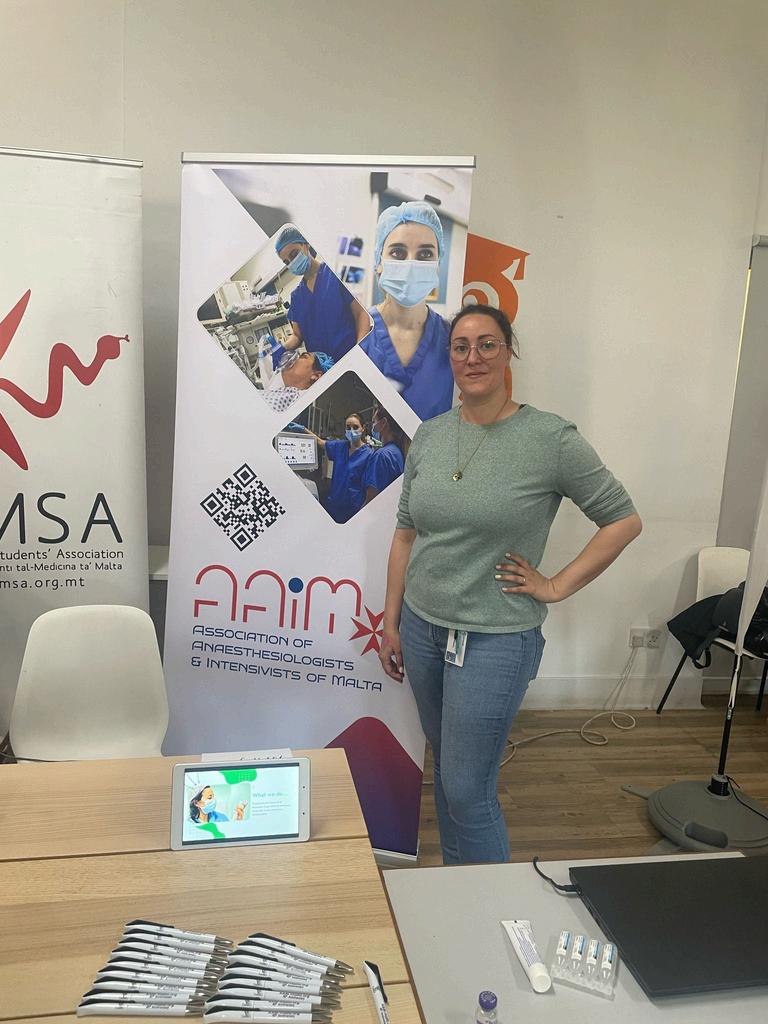
The AAIM committee and members were very active during the Euroanaesthesia 2025 Congress held in Lisbon, Portugal between the 25th and 27th May 2025. Dr. Anne Marie Camilleri Podesta, and Dr. Stephanie Mifsud also represented the AAIM in numerous ESAIC meetings in their respective roles of AAIM President and Secretary. Anne Marie chaired the NASC session as NASC chair and represented Malta presented at General Assembly and NASC session, whilst Stephanie attended the EBA UEMS meeting as the Maltese representative.
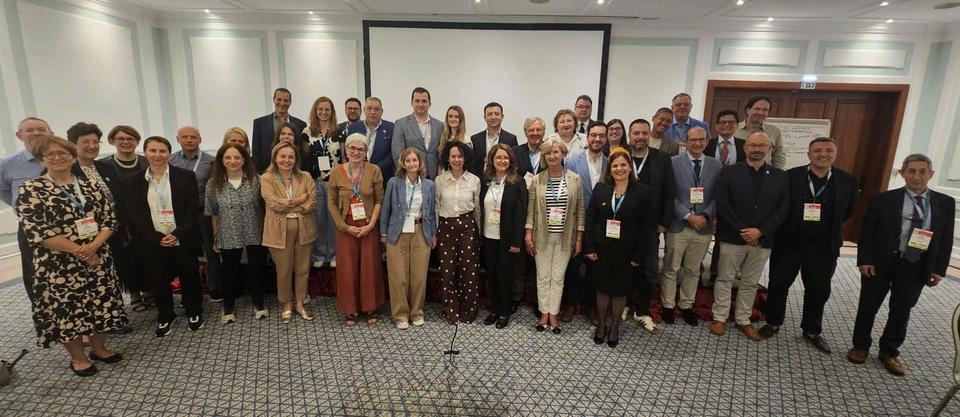
Originally drafted in 2009 and launched at the 2010 Euroanaesthesia Congress in Helsinki, the Helsinki Declaration on Patient Safety remains a cornerstone of anaesthesiology practice across Europe. Now, in 2025, an updated version was released to reflect advances in the field. The EBA, together with the ESAIC Patient Safety and Quality Committee and national representatives, has revised the declaration to address current challenges and reinforce patient safety standards. It continues to support key global initiatives, including the WHO-WFSA International Standards, the WHO Global Patient Safety Action Plan (2021–2030), and the WHO Patient Safety Rights Charter. We are proud to announce that Dr. Anne Marie Camilleri Podesta has signed the updated declaration on behalf of AAIM.
More information on: https://esaic.org/patient-safety/helsinki-declaration-on-patient-safety-in-anaesthesiology/
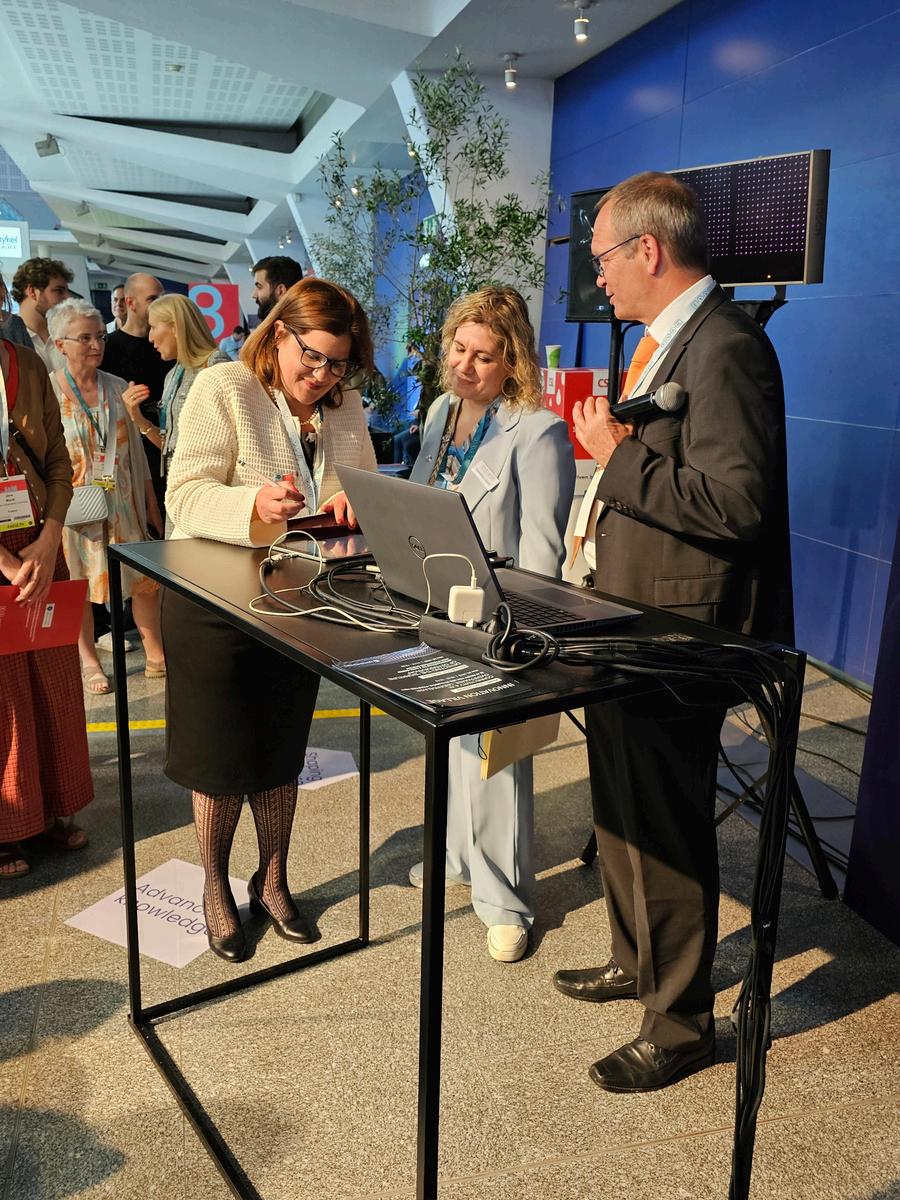
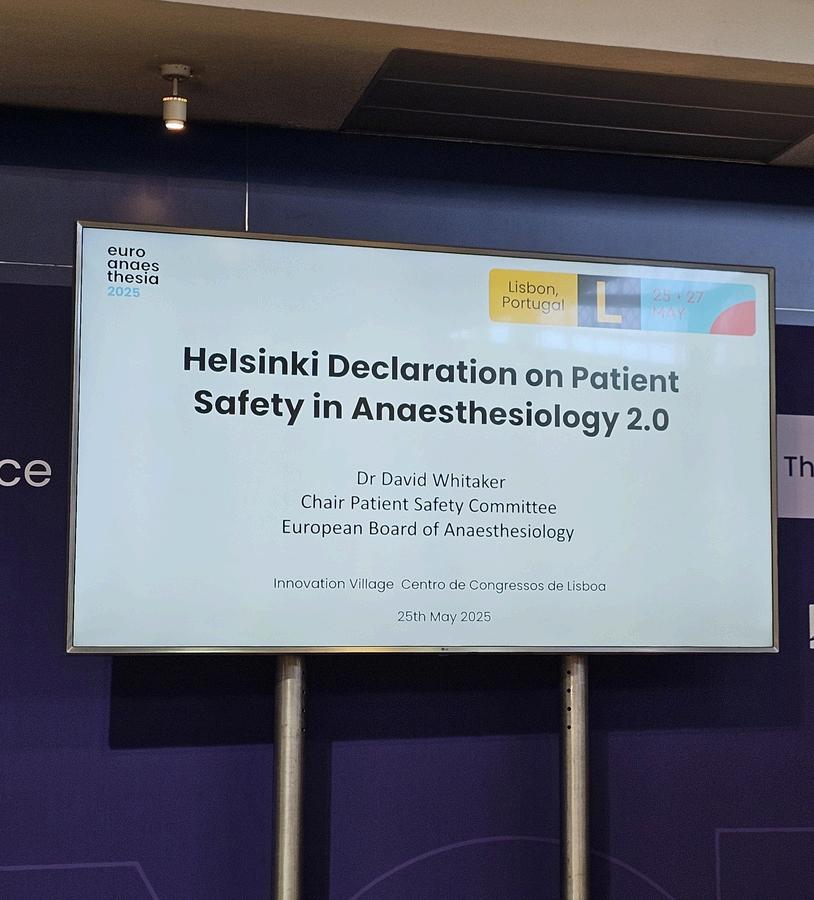
Dr Anne Marie Cammilleri Podesta signing the updated Helsinki declaration with Prof Benedikt Preckel, Chair of the ESAIC Patient Safety and Quality Committee (PSQC) looking on
Each year, the Euroanaesthesia Congress hosts the National Societies Village. This year’s theme was ‘Value-Based Patient Care in Anaesthesiology and Intensive Care’ The AAIM prepared a poster detailing our local endeavors pertaining to this theme, in addition to Maria, Adrienne, Sara, Juliet and Stephanie manning our stand to help promote the AAIM’s forthcoming APSC course and Malta. Special thanks to the Malta Tourism Authority for the merchandise provided.
More information on: https://euroanaesthesia.org/2025/national-societies-village/
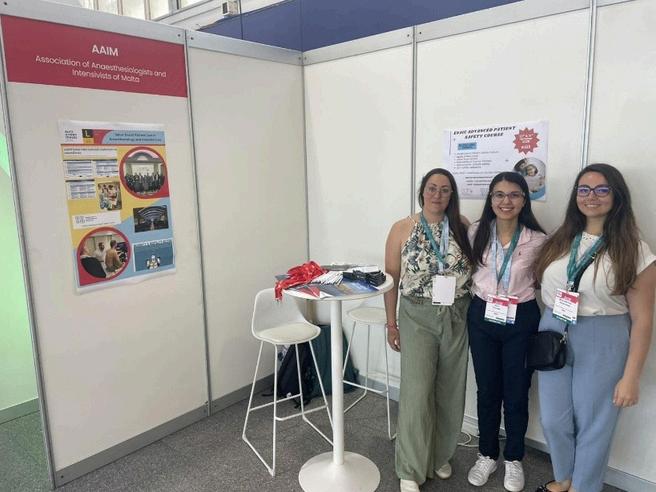
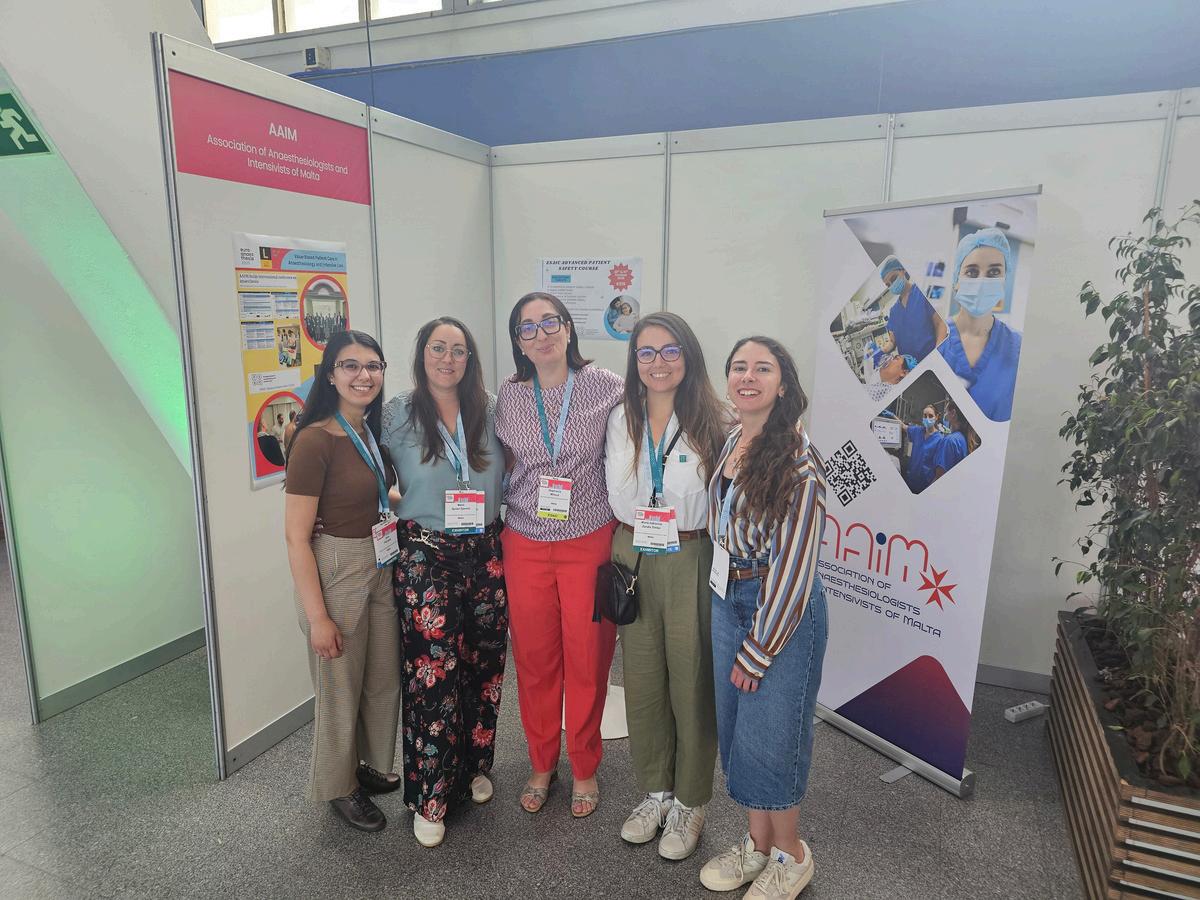
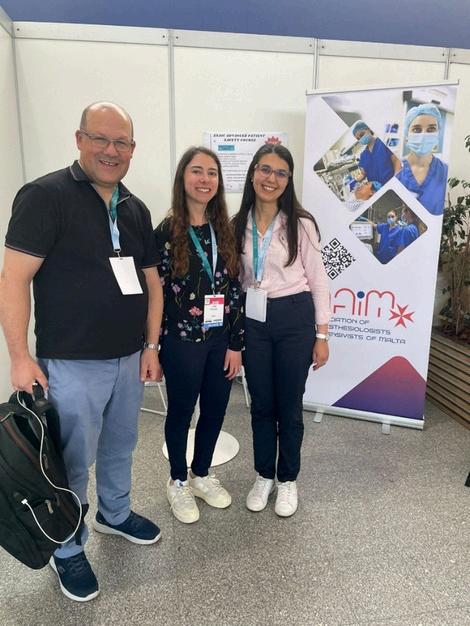
Dr. Mario Zerafa, Juliet and Sara at the AAIM stand.
The Santa Cruz Declaration emerged as a global commitment to improving patient outcomes through better blood use. Initially driven by Latin American leaders, it gained international momentum with endorsements worldwide. The WFSA has since advanced this effort by backing the WHO’s call to action and leading initiatives in Patient Blood Management (PBM), including a global outreach campaign to engage its member societies in support of the declaration. In fact, Dr. Anne Marie Camilleri Podesta, President of the Association of Anaesthesiologists and Intensivists of Malta (AAIM), signed the Santa Cruz Declaration during Euroanaesthesia 2025.
More information at: https://wfsahq.org/news/endorsing-the-santa-cruz-declaration-strengtheningblood-patient-management-globally/
AAIM President, Dr Anne Marie Camilleri Podesta, AAIM Secretary Dr Stephanie Mifsud and WFSA representative following the signing of the Santa Cruz declaration on PDM.
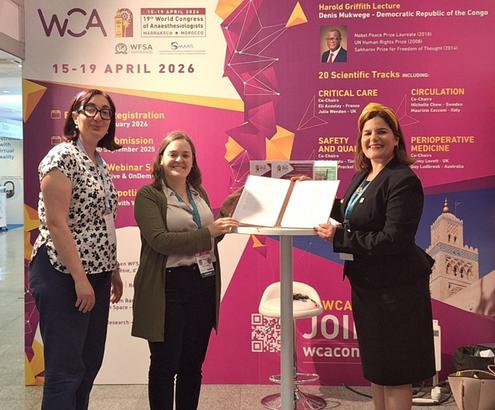
An encouraging number of our AAIM trainee members have presented their research at the Euroanaesthesia 2025 during the Poster presentation sessions.
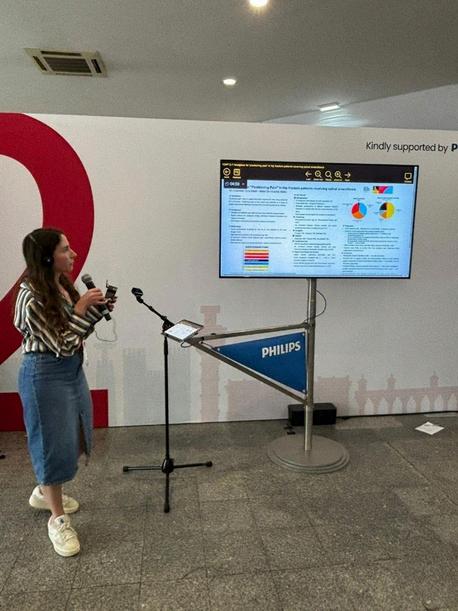
Dr Juliet Camilleri
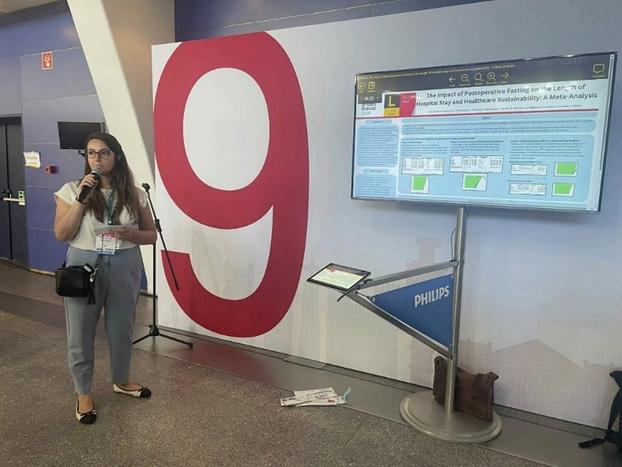
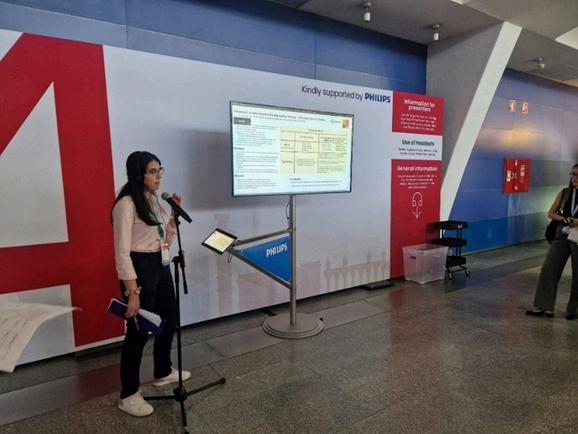
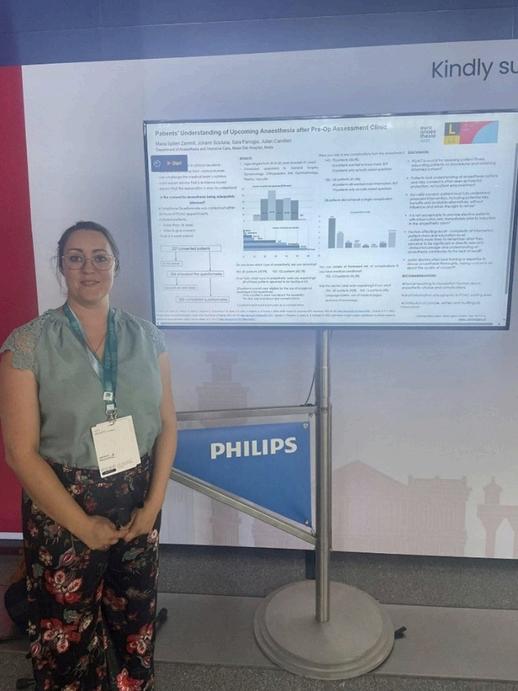
Dr Anne Marie Camilleri Podesta, AAIM President was awarded the Fellow of the European Society of Anaesthesiology and Intensive Care (FESAIC™). This is a prestigious honour awarded to healthcare professionals who have made a significant contribution to anaesthesiology and intensive care.
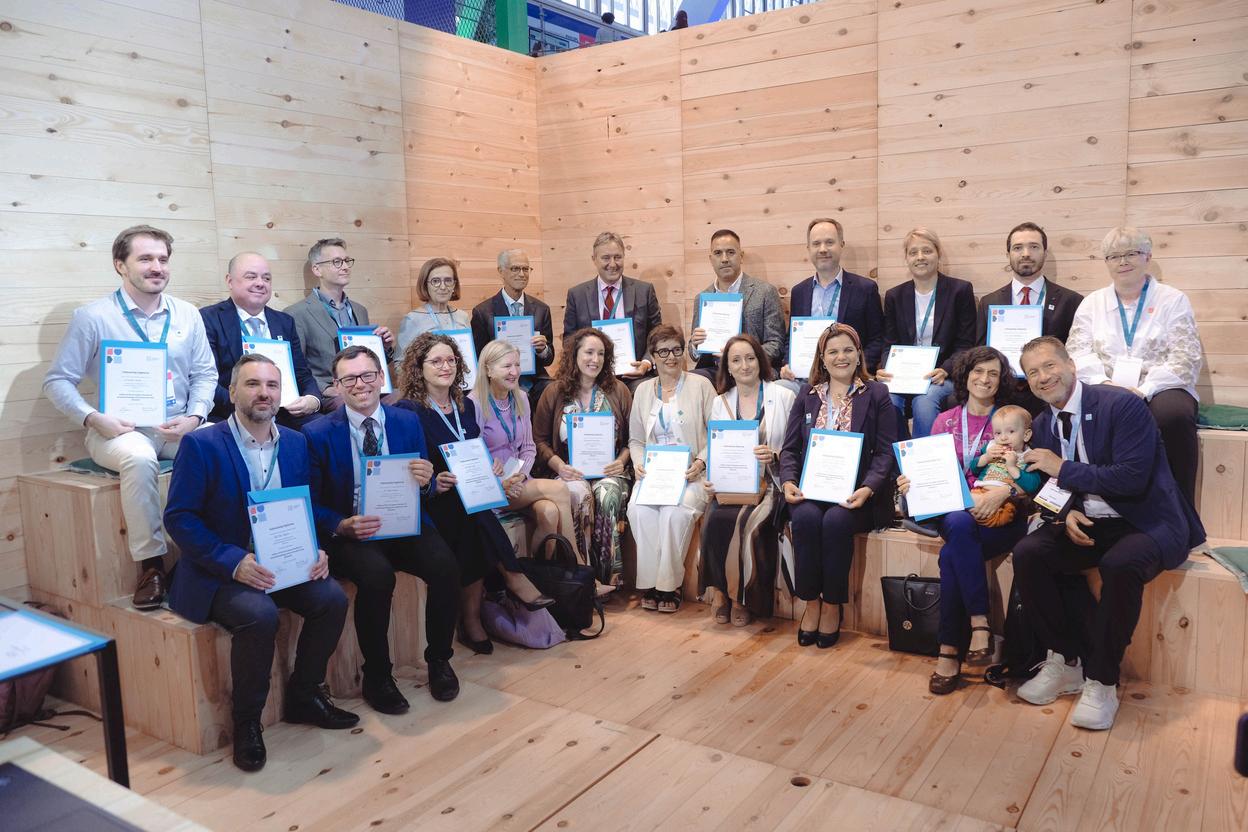
Dr Anne Marie Camilleri Podestà was awarded her FESAIC designation by Dr Else-Marie Ringvold, General Secretary of the ESAIC, and Professor Kai Zacharowski, former ESAIC President and founder of the FESAIC programme.
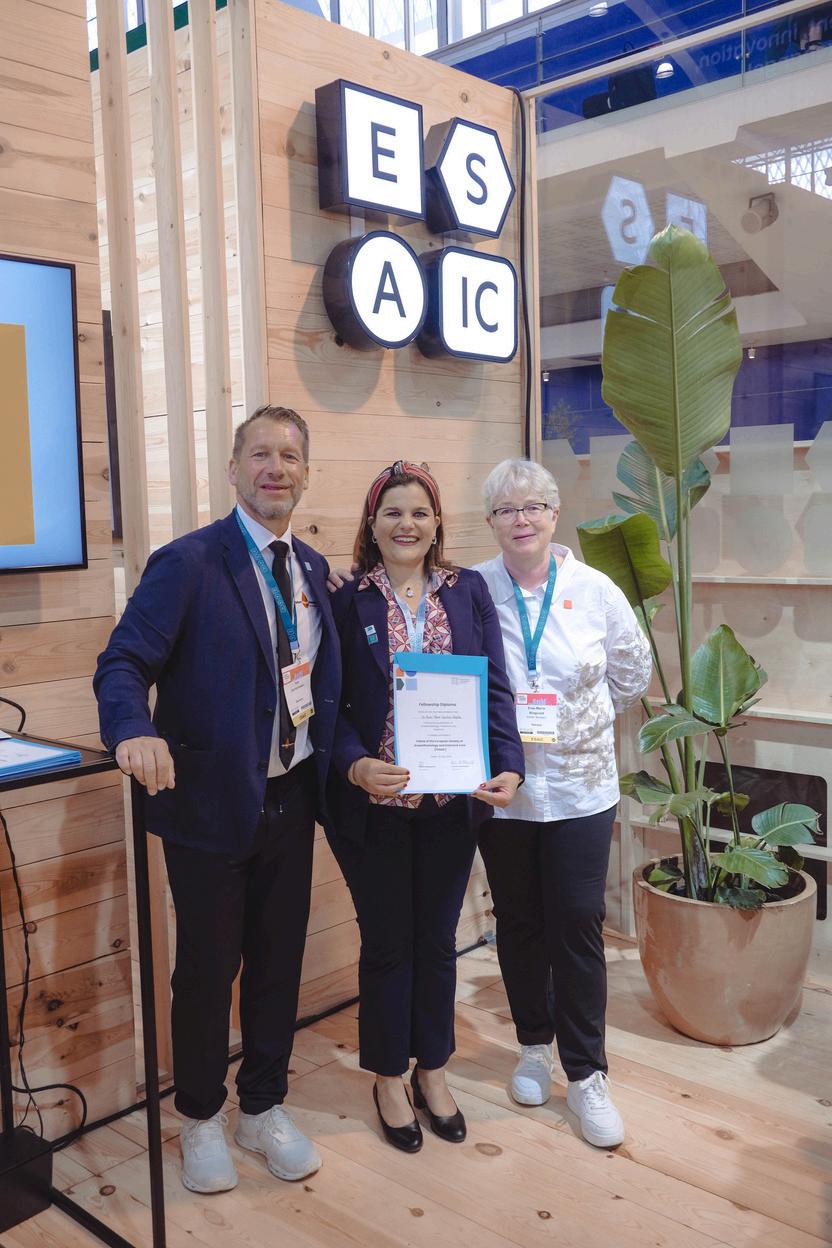
At the end of the 3 busy days at the Congress, most of the Maltese delegation met for dinner and a walk by the Tagus river in Lisbon.
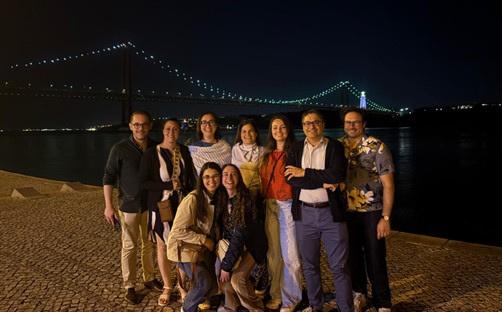
BSC MD
Hi Everyone,
It has been a privilege to serve as your Trainee Representative over the past few months. This role has been both demanding and highly rewarding, and I look forward to making the most of the remaining month of my term with the same enthusiasm and dedication.
Since assuming this position, I have worked closely with the AAIM Committee, Training Committee members, and our Head of Department to address ongoing and emerging challenges within our training programme and departmental operations. Together, we have been striving to enhance our educational and training experiences while improving the overall efficiency of our department, considering patient safety and trainee wellbeing.
Together, we have successfully organised several events, including Science in the City, World Anaesthesia Day, MedExpo Careers’ Day and our First Anaesthesia Congress These events have been instrumental in educating the public and our colleagues from other specialities about the crucial role of Anaesthesia and Intensive Care professionals. Furthermore, they have provided valuable networking opportunities for our members.
As our department continues to grow and evolve, we are presented with both new challenges and exciting opportunities for progress. My predecessors have set a high standard through their dedication to maximising the trainee experience and learning opportunities. I remain committed to building upon their efforts by further enhancing the benefits of our training programme, fostering a supportive and positive work environment, and actively contributing to the department’s continuous development.
I am dedicated to maintaining a high standard in this role and welcome any suggestions, ideas, or feedback. Please do not hesitate to reach out should you have any thoughts or concerns—I would greatly appreciate hearing from you.
Thank you for your continued support and engagement.
Best regards, Maria
Dr Yanika Stafrace
MD DESAIC
I have had the opportunity to do an experience doing voluntary work in Kenya for three weeks with the non-profit organization Right2Smile. This organization has many projects in different countries, including the project I was a part of in Olasiti community in Kenya. This project mostly involves the development of a local primary school in order to ensure the children in this remote rural community receive a wellrounded education.
My experience started on the 29th of July, when along with another seven volunteers from Malta, we arrived in this community and we spent three weeks living and working there. We were staying with different families from the community where we truly experienced their lifestyle and customs. We helped out in the day-to-day activities, including cooking traditional dishes, collecting firewood, looking after the cattle and even milking the cows whenever it was tea-time. I feel that this experience has given me a second family away from home, as spending so much time together has enabled us to have so many conversations about the difference and similarities in our cultures. It has also given me a shift in my perspective where I can appreciate more how fortunate we are to have certain commodities, like running clean water available all the time and the ample opportunities available to us.
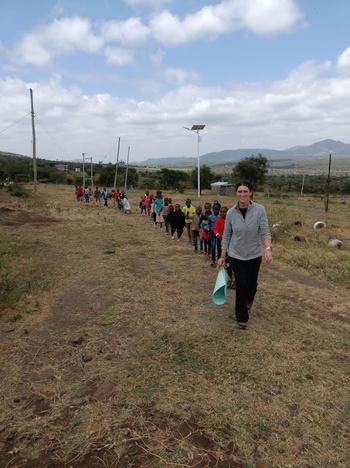
During the time of our experience, the primary school supported by our organization was closed as the children were on their holidays. So, we took this opportunity to organize a summer school, meaning attendance was not mandatory for the students and the classes being held did not follow a particular curriculum. We had a very good turn out for the summer school, with around 80 students attending every day, ages ranging from five years to seventeen years. The students were split into classes according to their ages and we organized a variety of classes including ICT, science, sports, music, arts and crafts and I even included a session on basic life support and first aid with the older students.
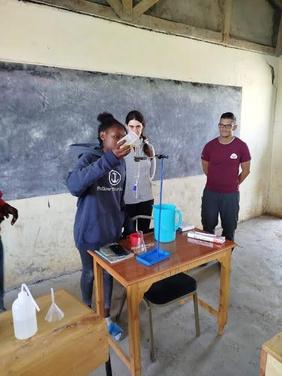
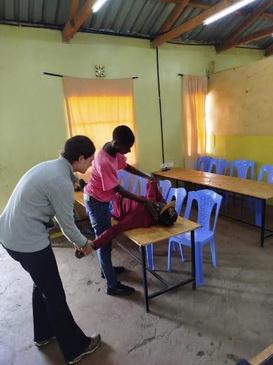
In the evenings we had a variety of sessions organized. A particularly interesting session was when we met with the women of the community and we had a discussion about the differences in our cultures but most especially on the role of the women in the community. Although at first glance it may appear that women’s rights may not be the same in Kenya compared to western countries, the women have a very respected role in the community and it was very illuminating to get to hear their stories. We also had sports sessions with the youth which they really enjoyed as in the past the volunteers did not do any sessions with the youth of the community. We also had many lovely walks with the elders of the community over the hills, looking for giraffes and going to the spring which is the main water source for the village. It was such a beautiful experience to be such a different environment, surrounded by untempered nature and experience the varied wild life.
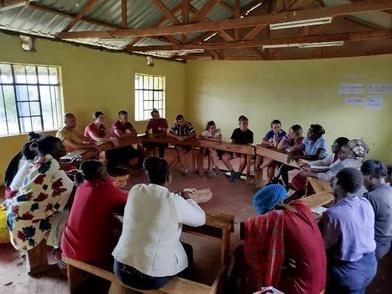
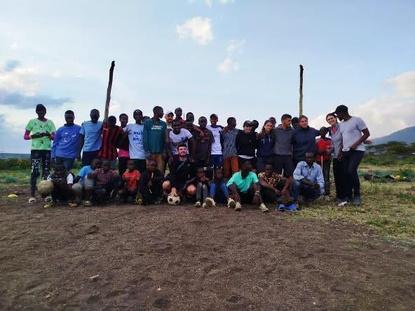
We also had the opportunity to visit other projects supported by Right 2 Smile. We spent a day at a child care centre in Kibera, which is one of the biggest slums in Africa. Although it was a very shocking experience to witness the poverty in this area, my heart was filled with hope to see the level of care that the teachers in this centre were providing the children who attend there. I was astonished by the respect and the value education has for these children. We also visited Tania where Right 2 Smile supports a school for disabled children which also is an orphanage. It was a great honour to meet the founders of this school, who despite their advanced age and limited resources, have dedicated their lives to making a home for these children. One of the founders, Mr. Joseph, was also the person who created sign language for Kenya! We helped out in the school itself by helping in the kitchen to prepare food for the children and staff, we planted spinach in the school farm, and we also worked in the bakery the school has that sells bread to help fund the school.
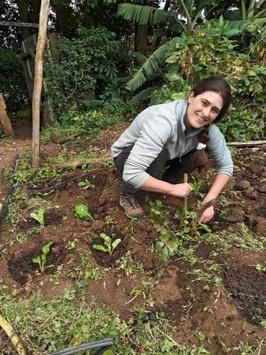
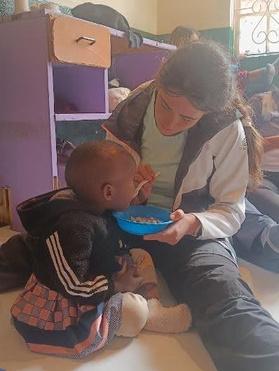
This experience has helped me to grow so much as a person. I went into this experience with the expectation to make some difference in the lives of the people I met. Little did I know that I would be the one who will come back as a different person. It has given me a new perspective in life; I appreciate more what we have here and my priorities have changed. It was a great privilege to be able to experience such a beautiful culture and get to know so many different people who despite the hardships in their life are so resourceful and so positive.
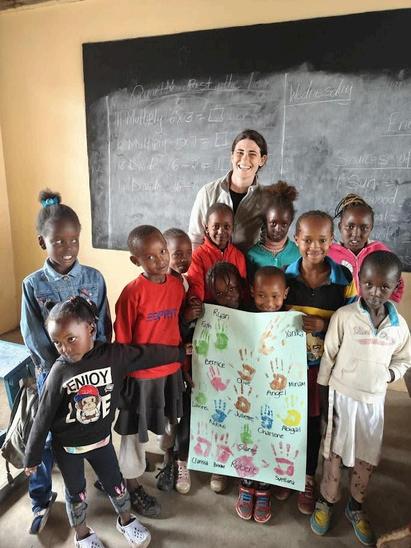
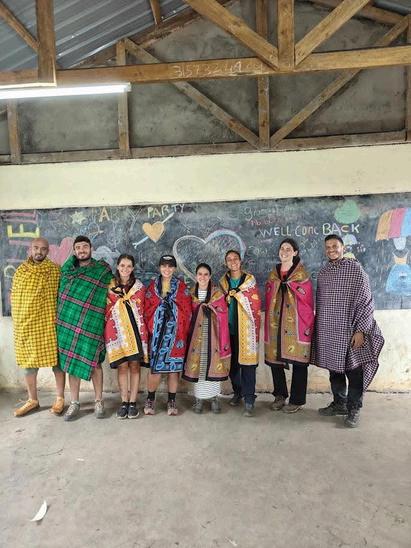
Dr Adrienne Zerafa Simler
MD MSC
Hello everyone,
My name is Adrienne Zerafa Simler, and I am an ST4 trainee currently undertaking my training year at University Hospitals of Leicester NHS Trust. I chose to spend my ST4 year abroad for several reasons, primarily to enhance my clinical experience and strengthen my portfolio. Additionally, I wanted to gain a broader perspective on anaesthetic practice in a different healthcare system, which could be valuable for future career opportunities. As the saying goes, the world is your oyster!
I opted to undertake this year abroad through a Memorandum of Understanding (MOU) rather than applying independently for an NHS position. This ensured that I was recognized as a Maltese trainee in training rather than a clinical fellow, which helped simplify administrative processes both locally and in the UK. The transition was further facilitated by the excellent clinical fellow team at the hospital, who provided guidance on essential matters such as setting up a bank account and finding accommodation. Their support made the relocation process significantly smoother.
From a training perspective, the experience has been excellent. Prior to my move, I had an online meeting with one of the college tutors who provided a detailed overview of my working structure. We discussed my e-portfolio and training requirements, and a plan was put in place to ensure that I could achieve all necessary competencies. Regular meetings with my educational supervisor, held twice per rotation, allowed for ongoing assessment and feedback. Additionally, my clinical supervisors were highly supportive, helping me integrate smoothly into each rotation. Leave arrangements, including vacation and study leave, were straightforward, provided applications were submitted six weeks in advance.
One concern I had before starting was the difference in training duration between Malta and the UK. While our training consists of five years (with an optional fellowship year), the UK system spans seven years, or eight for those subspecialising in ITU. At first, this discrepancy made me nervous, but I soon realized that the variation is largely due to differences in exams and working hours. Maltese trainees are highly regarded in the UK, and my experience has been no exception. Once I proved myself, I was entrusted with responsibilities equivalent to those of senior UK trainees. Looking back, I wish I hadn’t spent so much time worrying about it.
Beyond clinical training, Leicester has proven to be a good place to live. There is a strong Maltese trainee community here, including those undertaking fellowships. I also took the opportunity to reconnect with old friends. The city is well-connected, making travel around the UK easy and something I often do on weekends.
Overall, spending a year training abroad has been an incredibly rewarding experience, and I would encourage anyone considering it to take the opportunity.
While it does take some time to adjust, the benefits outweigh the initial challenges. If you are thinking of training abroad, here are a few recommendations:
Prepare your documentation well in advance – GMC registration, IELTS, and other requirements can take time.
Plan it well – Avoid scheduling your year abroad in your final year of training or between major exams.
Budget accordingly – Relocating is expensive, so make sure you budget well.
Choose your rotations wisely – Focus on the specialties you are interested in.
Consider the weather – If you prefer drier weather, the east coast of the UK is a better option than the west.
Take every opportunity – Say yes to new experiences and make the most of your time abroad.
I hope this helps! Feel free to message me if you have any questions.
Thanks, Adrienne
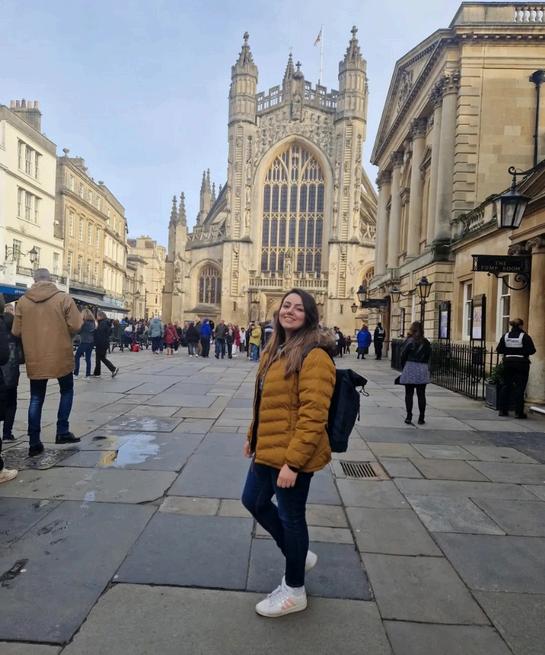
Dr Martina Gerada MD PGDiP MFTM RCPS (Glasg)
Sport has always been an integral part of my life. I discovered early on that I was always a competitive person, so channelling that energy into sport felt natural. By the age of 13, the athletics track was my second home. I trained nearly every evening during school term and twice a day in summer as a track and field sprinter. Making it into the national team and representing Malta abroad as part of the kids’ athletics team remains one of my proudest early achievements.
But like many athletes, I became closely acquainted with injury. A serious one brought my sprinting days to a halt — and strangely enough, it turned out to be a blessing in disguise. That was how I stumbled across handball, a sport I hadn’t paid much attention to before. I quickly fell in love with it and found my place between the posts as a goalkeeper. Switching from an individual sport to being part of a team was effortless, and I quickly felt at home.
I have been playing competitive handball with Kavallieri Handball Club for the past 16 years — through highs and lows, wins and injuries, and, of course, the ongoing challenge of balancing sport with life in medicine. There were periods, especially during the final years of medical school, when I had to completely step away from the court to focus on exams and clinical work. Even now, as a doctor working in anaesthesia and intensive care, that balancing act continues.
People often ask how I manage to juggle sport with such a demanding profession. The honest answer? I don’t always — not perfectly. But I do make space for it. Some days, I’ve shown up to matches straight after a night shift in ICU. (Ironically, I sometimes save more shots when I’m exhausted — too tired to overthink, and just going with the flow.)
Handball has quietly shaped the way I work. As a goalkeeper, I learned to read the smallest shifts in movement, to trust my team’s positioning, and to stay calm under pressure — all qualities that serve me well at work. The stakes may be different, but the mindset is strikingly similar.
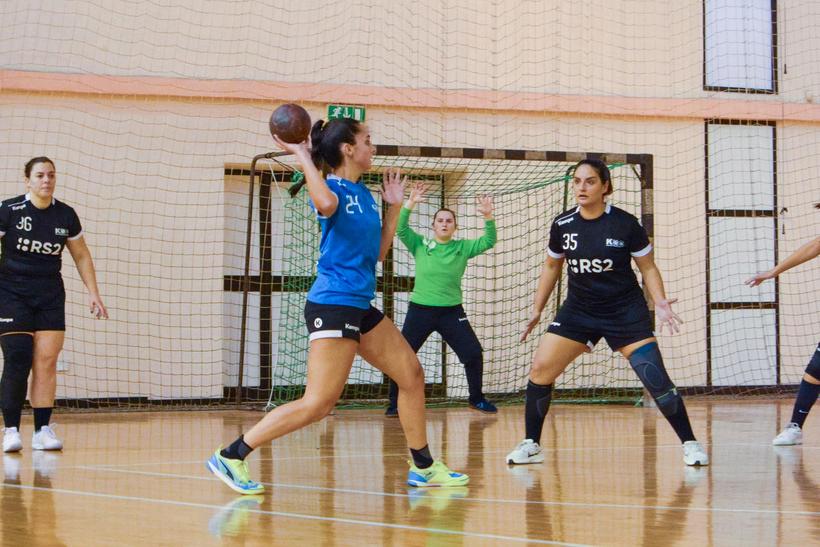
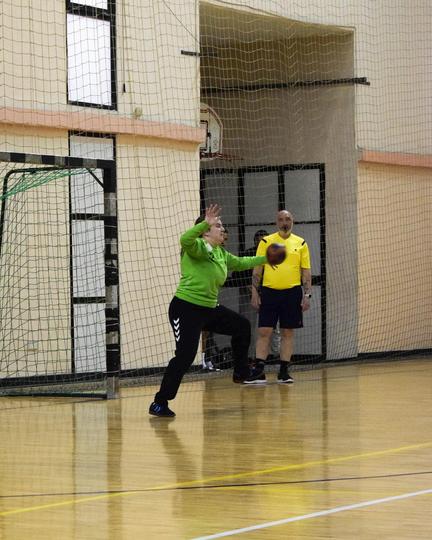
This past season was particularly special. After years of dedication and regrouping, my team became champions of Malta — winners of the Women’s National Handball League. I’ve celebrated smaller victories before: youth and second division trophies, representing Malta internationally, and even playing in a prestigious European club tournament - but this league win means the most. It was the culmination of months of commitment: late-night training sessions, juggling on-calls with match schedules, and always showing up — even when running on coffee and very little sleep. And my teammates did the same for me.
In Malta, handball isn’t a high-profile sport, but the women’s league is growing — and it deserves recognition. Many of us on the team are professionals: doctors, teachers, architects, students. We train and play not because it’s easy, but because it’s meaningful.
‘’Sport brings structure, identity, and community. It reminds us that success doesn’t come from individual effort, but from consistency, mutual support, and shared resilience — values that echo in the operating theatre, ICU and beyond.’’
Being part of a team, both on and off the court, keeps me grounded. It helps me bring my best self into my clinical work. And perhaps most importantly, it reminds me that rest, joy, and movement aren’t luxuries — they’re fuel. It is also comforting to know that no matter what life throws your way, there’s a team — your team — alway behind you.
Our handball club offers training sessions for anyone aged 4 and up, led by a team of dedicated and experienced coaches. If you or your children are interested in joining our handball family, feel free to reach out!
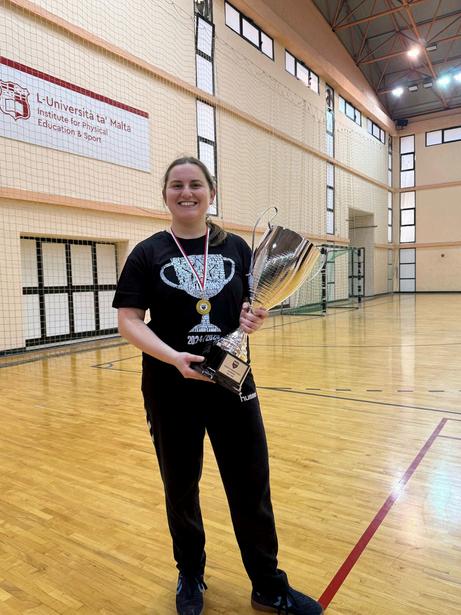
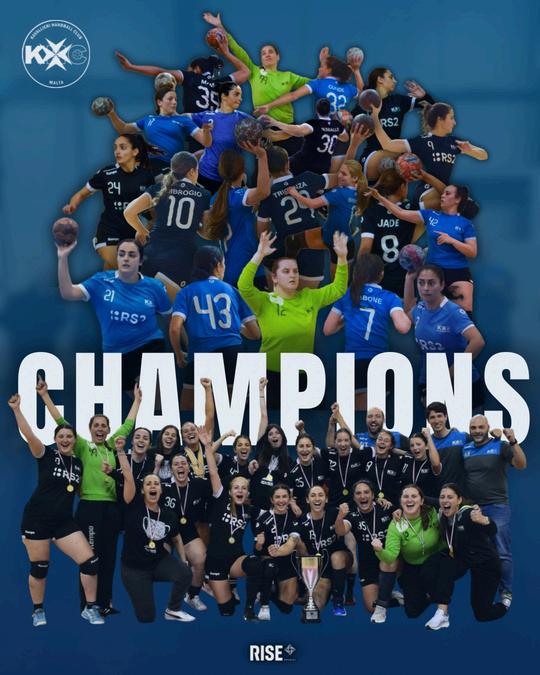
Dr Velitchka Schembri Agius MD MRCS DESA MSc (Trauma Sciences)
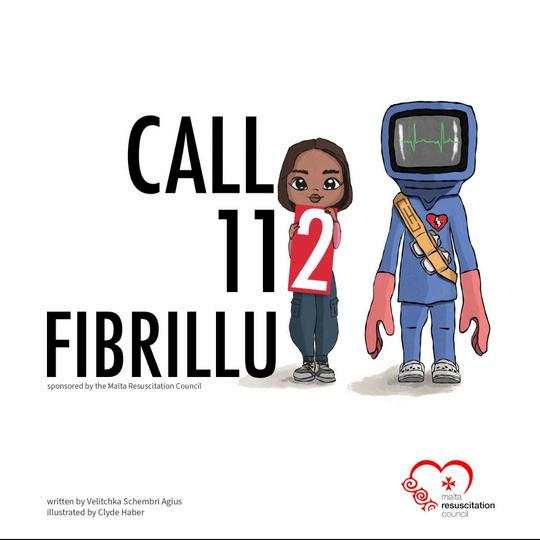
Malta's commitment to life-saving education took a significant leap forward with the presentation of "Call 112 Fibrillu" (also available in Maltese as "Ċempel 112 Fibrillu"), an innovative project aimed at empowering both pupils and teachers with essential first-aid knowledge, particularly in the critical area of cardiopulmonary resuscitation (CPR) and the use of Automated External Defibrillators (AEDs) This collaborative endeavor, spearheaded by Dr. Velitchka Schembri Agius and artist Captain Clyde Haber, in close partnership with the Malta Resuscitation Council, was recently presented to the Minister for Education, Hon. Clifton Grima.
The inspiration behind "Call 112 Fibrillu" was directly sparked by the ongoing, vital training carried out by teachers from the Health and Safety Unit, who diligently provide continuous education to pupils and teachers across schools in Malta Witnessing the positive impact of this training and recognizing the need for an accessible and engaging approach to a complex topic, such a project would make learning about cardiac emergencies more approachable for a younger audience
Teaming up with Captain Clyde Haber, a renowned artist known for his captivating storytelling through visual mediums, proved to be a pivotal collaboration. Captain Haber's artistic prowess has translated the intricate details of CPR and AED usage into an easily digestible and memorable format, likely through engaging illustrations, animated content, or interactive materials. The availability of a Maltese version, "Ċempel 112 Fibrillu," further underscores the project's commitment to accessibility and widespread adoption within the local context.
The involvement of the Malta Resuscitation Council further solidifies the project's credibility and adherence to international best practices in resuscitation A key figure in this collaboration was Dr Tanya Esposito, Chairperson of the Malta Resuscitation Council (MRC), whose tireless efforts were instrumental in pushing and facilitating the partnership with the Education Department and the Minister Her dedication ensured that the project gained the necessary institutional support and recognition. The Council's expertise ensures that the information conveyed through "Call 112 Fibrillu" is accurate, up-to-date, and aligned with established lifesaving protocols. This collaboration underscores the importance of a unified approach to public health education, bringing together medical professionals, educators, and artists for a common goal
The presentation to Hon Clifton Grima, the Minister for Education, signifies the government's recognition of the project's immense potential. Such an endorsement is crucial for integrating "Call 112 Fibrillu" into the national educational curriculum, ensuring its reach extends to every school and every student in Malta The initiative aims to equip future generations with the confidence and skills to respond effectively in a cardiac emergency, potentially saving countless lives
"Call 112 Fibrillu" is more than just an educational program; it's a testament to the power of collaboration and innovation in fostering a more prepared and resilient society. By making life-saving knowledge accessible and engaging, this project promises to leave a lasting legacy of empowered individuals ready to answer the call when every second counts.

Author Dr Velitchka Schembri Agius and illustrator Clyde Haber with copies of the book ‘Call 112 Fibrillu’
Education Minister Clifton Grima (third from left) being presented with the book by Tanya Esposito and Marius Caruana, chair and vice-chair of the Malta Resuscitation Council, supported by members of the Health and Safety Unit of the Education Department and other department representatives
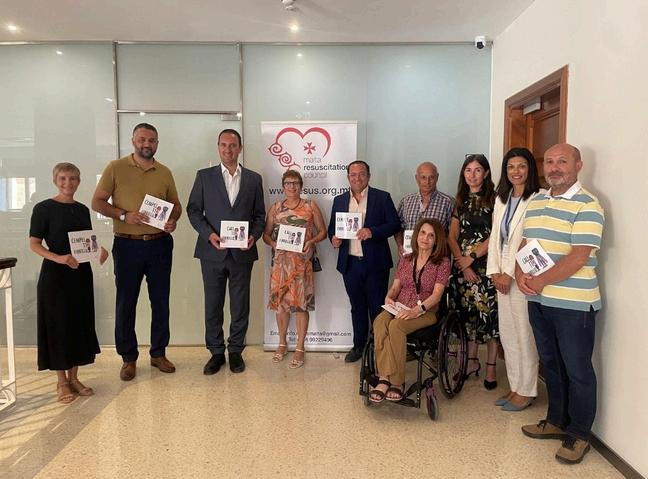
Congratulations on your appointment as National Anaesthesiologists Societies Committee (NASC) Chair!
Can you delineate what is NASC and its functions within the ESAIC? What inspired you to take up this role?
NASC, the National Anaesthesiologists Societies Committee, is a key body within the ESAIC that unites 42 national societies across Europe to promote excellence in anaesthesia and intensive care It acts as a vital link between societies and the ESAIC, fostering collaboration, harmonising training and safety standards, and supporting sustainable practices
As NASC Chair and Malta’s NASC representative I was inspired by the opportunity to represent national voices at a European level and help shape initiatives that reflect our shared priorities while respecting local contexts
What strategies does NASC propose to enhance anaesthesiology training programs across Europe, and how do we align with these initiatives to improve local training standards?
NASC supports the implementation of the European Training Requirement (ETR), promotes the EDAIC examination, and advocates for high-impact educational programmes such as the ESAIC Train the Trainer Masterclass. In Malta, we are strongly aligned with these initiatives through AAIM’s ongoing support of postgraduate training and active engagement in ESAIC’s educational activities
How can NASC facilitate collaboration between Maltese anaesthesiologists and intensivists and their European counterparts to promote research and knowledge exchange?
NASC fosters collaboration through surveys, webinars, cross-national research projects, and the NASC Village at Euroanaesthesia Malta is actively engaged and this demonstrates how smaller countries can contribute meaningfully to European-wide initiatives.
In light of the increasing demands on anaesthesia services, what measures does NASC recommend to ensure patient safety and quality of care, particularly in smaller countries like Malta?
NASC promotes the implementation of the updated Helsinki Declaration on Patient Safety an initiative Malta, through AAIM, helped shape by contributing to the final draft I hope to sign the Declaration on behalf of our association during Euroanaesthesia in Lisbon. We are also preparing to launch the ESAIC Advanced Patient Safety Course locally
How does NASC plan to address the issue of burnout among anaesthesiologists, and what support systems can be implemented to assist practitioners in Malta?
Rather than focusing solely on burnout, we are addressing broader workforce challenges, particularly the ageing anaesthesiology population and retention issues NASC encourages sustainable working conditions, better rota design, and adherence to the European Working Time Directive. These efforts are highly relevant in smaller systems like Malta’s, where workforce resilience is crucial
What challenges have you identified for the future? Any final comments?
Challenges ahead include harmonising training, addressing workforce shortages, and embedding sustainability into everyday practice. However, with my roles on several ESAIC committees including Guidelines, Patient Safety and Quality, Trainee, and Sustainability alongside my position as ESAIC Board Director, I have direct visibility on key initiatives. This allows me to ensure alignment, bring relevant projects to national societies, and foster meaningful collaboration across Europe
As both NASC Chair and AAIM President, I am proud to represent Malta at this level and remain committed to ensuring that our national voice contributes to shaping the future of anaesthesia and intensive care.
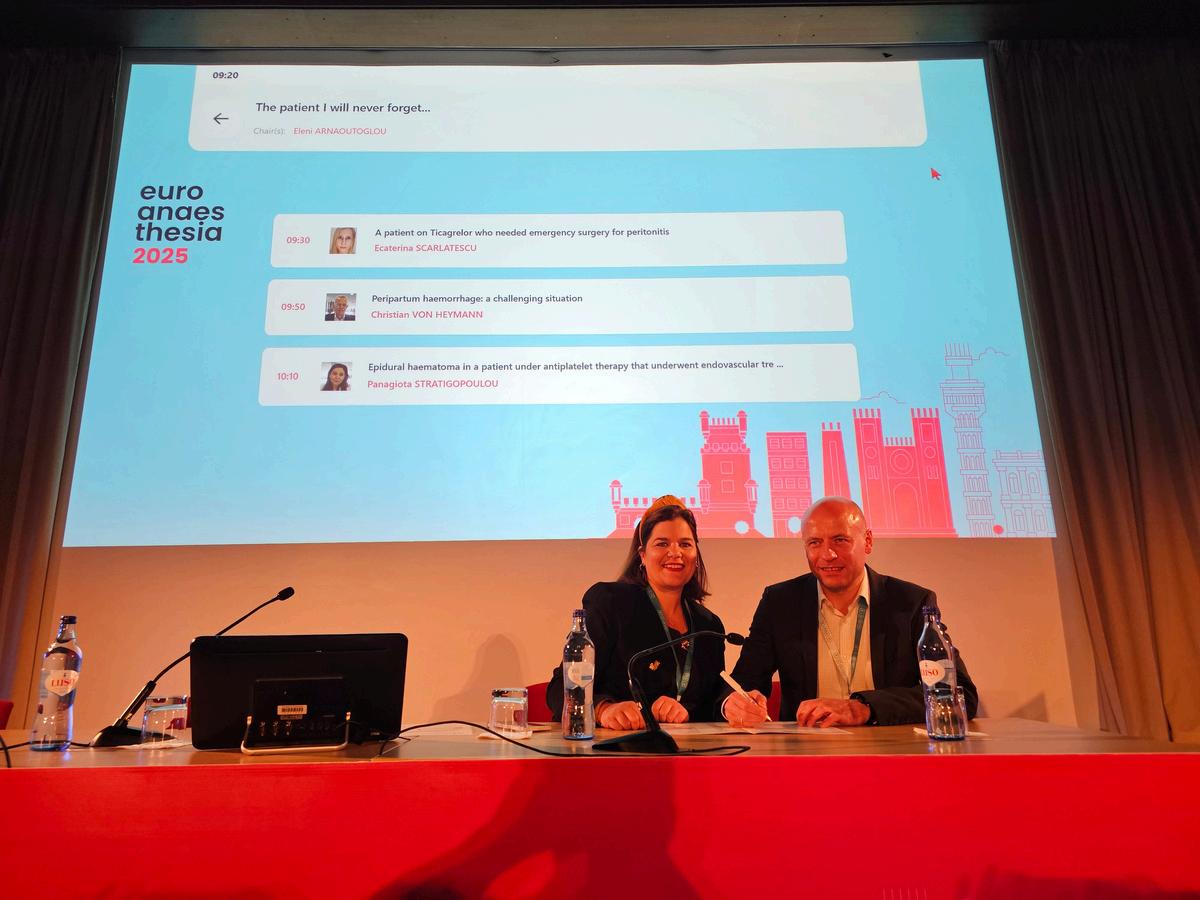
Dr Stephen Sciberras MD, MRCP (UK), DESA, EDIC, PG Cert US (Melbourne), PHD
Being an examiner requires staying current with evolving knowledge while also recognizing the limitations of less experienced candidates. The role offers many rewards: opportunities to network with international colleagues, to stay up to date with both subject matter and pedagogical approaches, and to gain recognition within a professional community. For trainers, serving as an examiner provides valuable insight into the intricacies of the examination process.
Being an examiner requires staying current with evolving knowledge while also recognizing the limitations of less experienced candidates. The role
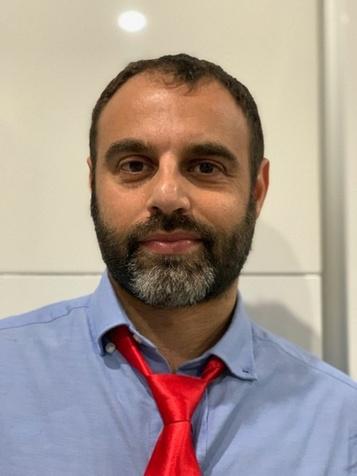
offers many rewards: opportunities to network with international colleagues, to stay up to date with both subject matter and pedagogical approaches, and to gain recognition within a professional community. For trainers, serving as an examiner provides valuable insight into the intricacies of the examination process.
Take, for example, the ESAIC and ESICM final examinations. The ESICM follows a more rigid format, requiring all candidates to sit the same questions on the same day in different centres. In contrast, the ESAIC adopts a more flexible approach, relying on examiners themselves to ensure consistent standards, with practically every candidate having a different set of questions. Having experienced both systems, one quickly realizes that no method is perfect — each has its own strengths and weaknesses.
This is precisely why trainers should also be examiners: understanding how assessments are conducted equips them to better guide candidates in their preparation.
For trainees preparing for any examination, I can confidently say the process is rigorous. Examinations undergo extensive planning to ensure fairness. Every question is reviewed multiple times by different reviewers, with ambiguous items carefully examined. Performance data is analyzed after each session — both for candidates and examiners — to maintain high standards.
Ultimately, success in an exam does involve a degree of luck, but more importantly, it depends on the impression you make. Confidence plays a crucial role — and it’s something every candidate should strive to project.
Dr Stephanie Mifsud BSC MD DESAIC MSC
Anaesthesiology has evolved significantly over centuries, marked by advancements in anaesthetic agents, administration techniques, and equipment, leading to improved patient safety. However, modern anaesthesiology faces multifaceted challenges, including inherent risks of anaesthesia, patient-related factors, and systemic and organisational issues, particularly in low- and middle-income countries. Some of the current challenges include:
Anaesthesia-related risks include nausea (up to 30% of patients), respiratory complications, and cardiovascular issues, with allergic reactions occurring in 0.1-0.01% of cases.
Patient factors such as obesity, advancing age, cannabis use, and pre-existing conditions can increase anaesthesia risks, necessitating thorough preoperative assessments.
Anaesthesiologists experience high workloads, burnout, and legal pressures, which can compromise patient safety. (Harfaoui et al., 2024).
The ESAIC is committed to ensuring and improving Patient Safety for anaesthesia, perioperative medicine, intensive care medicine, and pain medicine through the ESAIC Patient Safety and Quality Committee (PSQC). This has been highlighted in practice through various initiatives including:
Launching, the The ESAIC Safer Care to Save Lives (SCSL) Patient Safety Ambassador’s programme during Euroanaesthesia 2024 in Munich, Germany.
Co-signing of the updated Helsinki Decleration on Patient Safety in Anaesthesiology 2.0 between the ESAIC, EBA and NASC during the Euranaesthesia 2025.
Establishment of the PRiPSAIC, the Peer Review in Patient Safety for Anaesthesiology and Intensive Care, which runs peer-to-peer reviews between hospitals or institutions. The AAIM is collaborating with our departmental chairman Dr Godfrey Azzopardi in order to organise the PRiPSAIC in our department later on this year.
The ESAIC Safer Care to Save Lives (SCSL) Patient Safety Ambassador’s programme contains elements to achieve these goals through education, peer to peer networking, inter-hospital PS reviews and the promotion of the Helsinki Declaration in Anaesthesiology, a recognised leadership statement on what is practical to improve patient safety in perioperative anaesthesiology and intensive care. Healthcare professionals who complete all the elements of the SCSL Patient Safety Ambassador’s Programme, were recognised officially as ESAIC Patient Safety Ambassadors in a dedicated celebration during a ceremony at Euronaesthesia 2025 in Lisbon. Certified Ambassadors will receive a checklist of project options to implement within their departments or institutions. They are encouraged to collaborate with other specialities, fostering cross-disciplinary engagement while integrating these initiatives into their daily practice.
The elements of this Ambassador’s programme include:
1 The Essential Patient Safety Course a series of eLearning modules on the ESAIC Academy covering essential knowledge for those starting their journey into Patient Safety. It is complementary for Active ESAIC members.
2.The Advanced Patient Safety Course, a 1.5-day certification course containing tools for daily practice.
3 Patient Safety and Quality Masterclass, a deeper dive into mastering aspects of perioperative safety through a 2.5-day course.
The ESAIC Advanced Patient Safety Course is an in-person course to teach patient safety tools to use in acute settings. The AAIM is pleased to announce that it has signed an agreement with the ESAIC to organise an edition of the APSC on Thursday 30th and Friday 31st of October 2025 in Malta. We are honoured to welcome Prof. Benedikt Preckel as part of the international faculty, alongside our own local faculty Dr Stephanie Mifsud and Dr Karen Torpiano. With a competitive fee of €225, this 1.5-day course is a unique opportunity to engage in case-based discussions, exchange clinical insights, and build practical strategies to enhance patient safety in your practice. Participant numbers will be limited to ensure a focused and enriching learning environment.
Intended Audience:
The APSC is aimed at all Health Care professionals, interested in patient safety in acute settings: Intensive Care, Perioperative Care, Anaesthesia, Emergency and other settings where acute patients are managed.
Gain a comprehensive understanding of patient safety culture across acute care settings
Learn practical tools for error analysis, critical incident reporting, and system improvement
Explore the role of human factors in managing crises and improving team dynamics
Leave equipped to advocate for and lead patient safety initiatives in your workplace
Access to the Digital APSC Student Manual (pre-course reading and post-course reference)
A Certificate of Attendance issued by ESAIC, upon completion and passing the online assessment
Duration: 1.5 days
Date: 30th and 31st October 2025
Fee: 225 Euros
Venue: To be announced
APSC faculty candidates will be recruited from the PSQ Masterclass and APSC attendees and through consultation with the relevant National Societies.
Visit www.aaimalta.com or email info@aaimalta.com for registration details, payment options and updates.
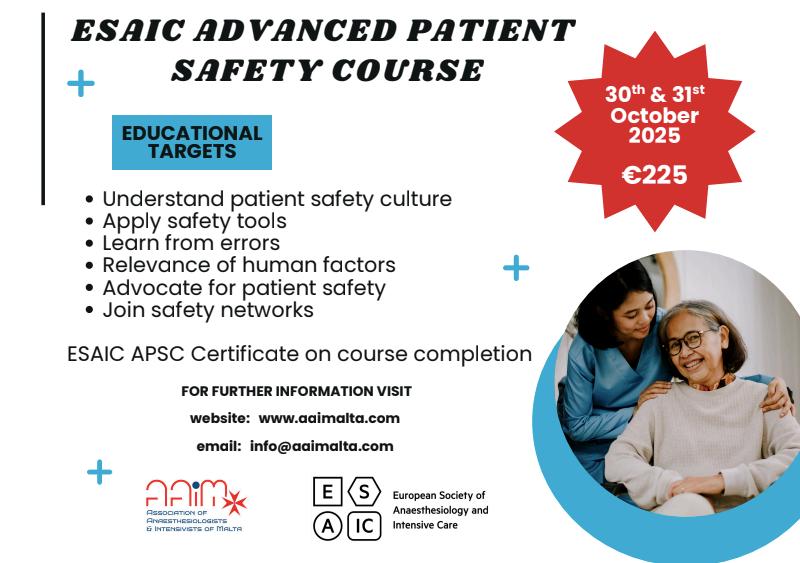
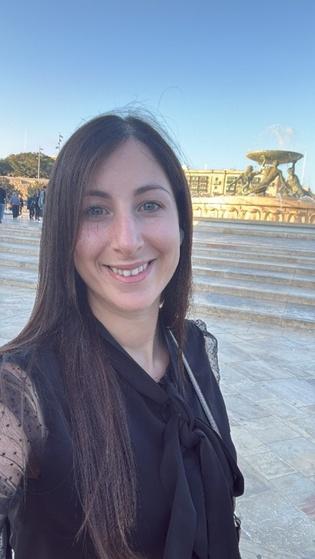
Study
Vasopressin vs Norepinephrine as Initial Therapy in Septic Shock (VANISH) clinical trial of 2016
Dr Kristina Ellul MD DESAIC
I attended the 44th International Symposium on Intensive Care and Emergency Medicine (ISICEM) in Brussels last March, where the latest practices, research and trials relating to intensive care were presented and discussed. Below are some interesting points that might have an impact on our practise locally.
Multiple trials were presented on the use of vasopressin, as a second-line adjunctive agent with noradrenaline, in vasodilatory shock.
Study Population
Adult patients with sepsis requiring vasopressor treatment across 18 ICUs.
Vasopressin in Septic Shock Trial (VASST) RCT
Over 16 years old with septic shock in 27 centres
Results and Conclusions
No statistical difference in the noradrenaline or vasopressin group with regards to 28-day, ICU or hospital mortality rates, fewer patient required renal replacement therapy (RRT) in the vasopressin group compared with the norepinephrine group.
No significant difference in 28-day mortality between patients with noradrenaline infusion alone vs vasopressin infusion added to noradrenaline. However, the patients with the addition of vasopressin had lower heart rates and lower noradrenaline requirements.
Sacha and Bauer published a narrative review in 2023, ‘Optimizing Vasopressin Use and Initiation Timing in Septic Shock’
Narrative Review
Focused on timing of initiation of vasopressin in septic shock, since optimal timing remains unclear in both the literature and clinical guidelines
Recent observational studies suggest that introducing vasopressin earlier (at lower norepinephrine-equivalent doses or lower lactate levels) may be linked to improved survival rates, however further research is required.
The AKIKI 1 (Artificial Kidney Initiation in Kidney Injury) trial, confirmed that a delayed renal replacement therapy (RRT) strategy is safe and can reduce the need for RRT with no significant difference in 60-day mortality in ICU patients with severe AKI.
It was followed by the AKIKI 2 trial which was designed to evaluate whether an ultra-delayed strategy was beneficial compared to the standard delayed strategy used in AKIKI 1. Patients were randomised into two groups: standard delayed RRT (as per AKIKI, RRT started when complications developed) and ultra-delayed RRT (RRT was postponed even further, beyond the criteria used in AKIKI). There was no mortality benefit with further delaying RRT, and more patients in the ultra-delayed group developed severe complications, such as fluid overload and electrolyte imbalances, requiring emergent RRT. The proportion of patients avoiding RRT was similar between the 2 groups. Therefore, further delaying RRT beyond the delayed strategy used in AKIKI 1 (>72 hours) does not provide additional benefits and may increase complication risk.
Li R et al. (2022) published a meta-analysis of 13 RCTs including 1612 patients, comparing the efficacy and safety of regional citrate anticoagulation (RCA) versus heparin anticoagulation during CRRT in critically ill patients. There was no significant mortality difference and no difference in metabolic acidosis between RCA and heparin groups, however the use of RCA was associated with:
• Significantly longer filter life
• Significantly reduced risk of bleeding events
• Lower incidence of heparin-induced thrombocytopenia
Higher risk of hypocalcaemia was observed in the RCA group, so replacement and regular monitoring of calcium is required.
These findings are similar to those published in JAMA in 2020 by Zarbock et al., where approximately 600 patients were divided in RCA group and systemic heparin group. Compared with the systemic heparin group, the RCA group had significantly longer filter life span and fewer bleeding complications. This trial was terminated early and was underpowered to reach conclusions about the effect of anticoagulation strategy on mortality.
The Brussels consensus, known as B-ICONIC, provides comprehensive recommendations for noninvasive intracranial pressure (nICP) monitoring in traumatic brain injury (TBI) patients, particularly in settings where invasive monitoring is unavailable. Developed by a panel of 41 experts through systematic reviews and a modified Delphi process, this consensus offers 34 recommendations (32 strong, 2 weak). These recommendations aim to guide clinicians in managing TBI patients using non-invasive methods.
Preference for Invasive Monitoring: In severe TBI patients (GCS <9) with radiological signs of intracranial hypertension, invasive ICP monitoring is preferred when available and not contraindicated.
Preferred nICP Tools: The consensus strongly recommends using the following tools for non-invasive ICP estimation:
Neurological Pupil index (NPi) from automated pupillometry
Pulsatility Index (PI) from transcranial Doppler (TCD) or transcranial color- coded duplex (TCCD) nICP values derived from TCD/TCCDOptic Nerve Sheath Diameter (ONSD) measurements
Multimodal Approach: Employing at least two different nICP modalities is strongly recommended over single-method assessments to enhance accuracy.
Integration with Clinical Assessment: nICP measurements should be integrated with clinical evaluations and neuroimaging findings as soon as possible after hospital admission.
Serial Monitoring: Regular serial nICP assessments are advised to monitor changes in ICP over time.
Following the 1999 TRICC trial, the transfusion threshold in critically ill patients has been set between 79g/dl, as this results in less blood transfusions and its associated costs and potential complications, compared with the previously higher (>9g/dl) threshold, with no adverse effects. However, only a small number of patients with TBI were included in the cohort, so 3 trials were done to include neurology patients.
Study
TRAIN trial (2024)
Intervention
Patients with various acute neurological injuries (including TBI, ICH, and SAH) were assigned to either a liberal transfusion approach (transfusion if Hb <9g/dL) or a restrictive approach (transfusion if Hb <7g/dL)
Liberal strategy group had a lower incidence of poor neurological outcomes at 180 days compared to the restrictive group—62% vs 72% overall, and 66% vs 76% among patients with SAH.
HEMOTION trial (2024)
Patients with moderate or severe TBI (GCS 3-12), comparing a liberal transfusion threshold (transfuse if Hb <10g/dL) with a restrictive one (<7g/dL).
SAHaRA trial (2024)
Evaluated the impact of liberal (transfusions if Hb <10g/dL) vs restrictive (transfusions if Hb <8g/dL) transfusion strategies in patients with aneurysmal SAH.
No significant difference in mortality between the two groups, 73.5% of restrictive group patients had a Glasgow outcome scale-extended of <4, vs 68.4% in the liberal group, Thus, a poorer functional outcome was reported in the restrictive group.
Similar to HEMOTION trial. Mortality rates at 12 months were similar between both groups; neurological outcome at 12 months in the restrictivestrategy group was poorer (37.7% had modified Rankin scale of 4 or more) than the liberal-strategy group (33.5% had modified Rankin scale of 4 or more). Also, lower incidence of radiographic vasospasm in the liberal (31.5%) compared to restrictive group (40.7%).
Bibliography:
1. Vasopressin:
VANISH trial - https://pubmed.ncbi.nlm.nih.gov/27483065/ VASST trial - https://pubmed.ncbi.nlm.nih.gov/18305265/ Optimizing Vasopressin Use and Initiation Timing in Septic Shock: A Narrative Review - https://pubmed.ncbi.nlm.nih.gov/37479058/
2. Renal Replacement Therapy:
AKIKI 1 - https://pubmed.ncbi.nlm.nih.gov/27181456/ AKIKI 2 - https://pubmed.ncbi.nlm.nih.gov/33812488/
3. Anti-coagulation for CRRT:
Regional citrate versus heparin anticoagulation for continuous renal replacement therapy in critically ill patients: A meta-analysis of randomized controlled trialshttps://pubmed.ncbi.nlm.nih.gov/35385216/ Effect of Regional Citrate Anticoagulation vs Systemic Heparin Anticoagulation During Continuous Kidney Replacement Therapy on Dialysis Filter Life Span and Mortality Among Critically Ill Patients With Acute Kidney Injury: A Randomized Clinical Trial - https://pubmed.ncbi.nlm.nih.gov/33095849/
4. ICP monitoring:
B-ICONIC - https://pubmed.ncbi.nlm.nih.gov/39847066/
5. Transfusions in TBI:
TRICC trial - https://pubmed.ncbi.nlm.nih.gov/9971864/ TRAIN trial - https://pubmed.ncbi.nlm.nih.gov/39382241/ HEMOTION trial - https://pubmed.ncbi.nlm.nih.gov/38869931/ SAHaRA trial - https://pubmed.ncbi.nlm.nih.gov/39655786/
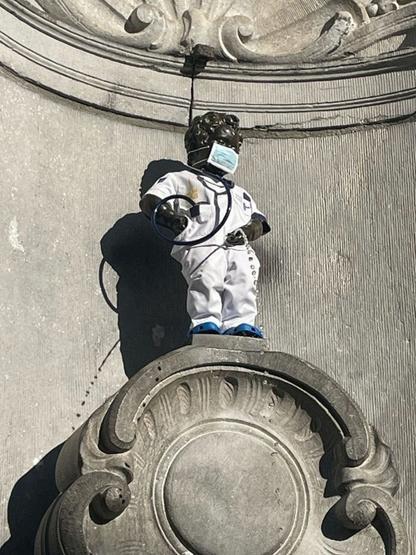
Manneken Pis in intensivist regalia for the duration of the ISICEM conference
The Association of Anaesthesiologists and Intensivists of Malta (AAIM) proudly held its international conference, The High-Risk Patient: Anaesthesia, Intensive Care, and Pain Perspectives, on 21st–22nd February 2025 at the Malta Marriott Resort & Spa, St. Julian's. This prestigious event welcomed over 200 delegates including local and international anaesthesiologists, trainees, anaesthetic and intensive care nurses, and other professionals with a shared interest in managing high-risk patients. We were pleased to welcome delegates from Ghana, the UK, Ireland, Norway, Latvia, and Ukraine, alongside a strong representation from the local community. The conference featured two days of insightful discussions, expert presentations, and active knowledge exchange, and was very well-attended and received excellent feedback from participants.
On the morning of Friday, 21st February, delegates had the opportunity to attend seven preconference workshops, covering a range of essential topics: Simulation for the High-Risk Patient, Echocardiography, Ultrasound-Guided Regional Anaesthesia, Patient Safety and Non-Technical Skills, Introduction to Tracheostomies, Central Venous Access and Vasoactive Drugs, and Difficult Airway Management.
Led by an experienced faculty, the workshops were designed to be highly interactive and hands-on, attracting 102 participants across various grades, professions, and nationalities. The feedback received was overwhelmingly positive, reflecting the relevance and quality of the sessions. In parallel, the Malta Resuscitation Council (MRC) also held an ALS Re-Certification Course as part of Day 1 of the conference.
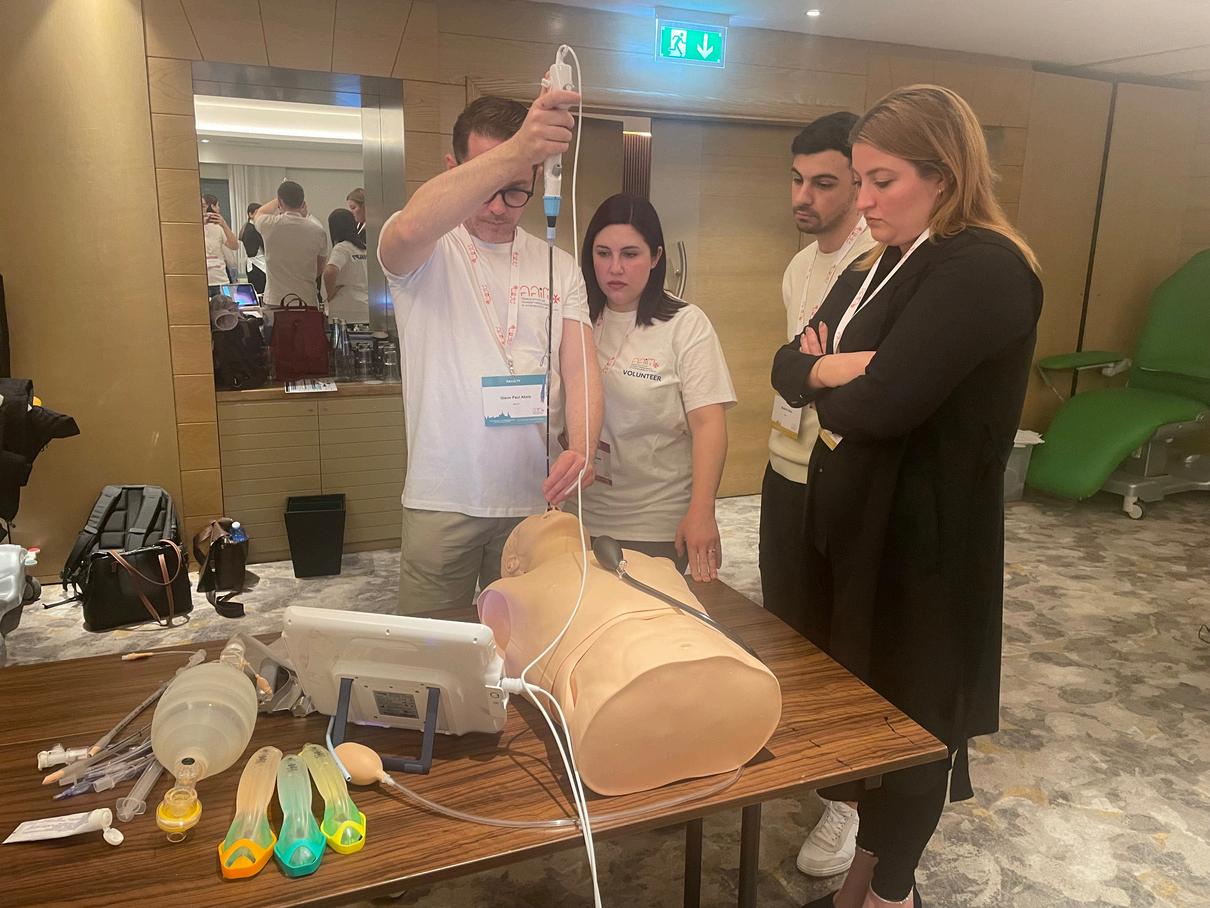
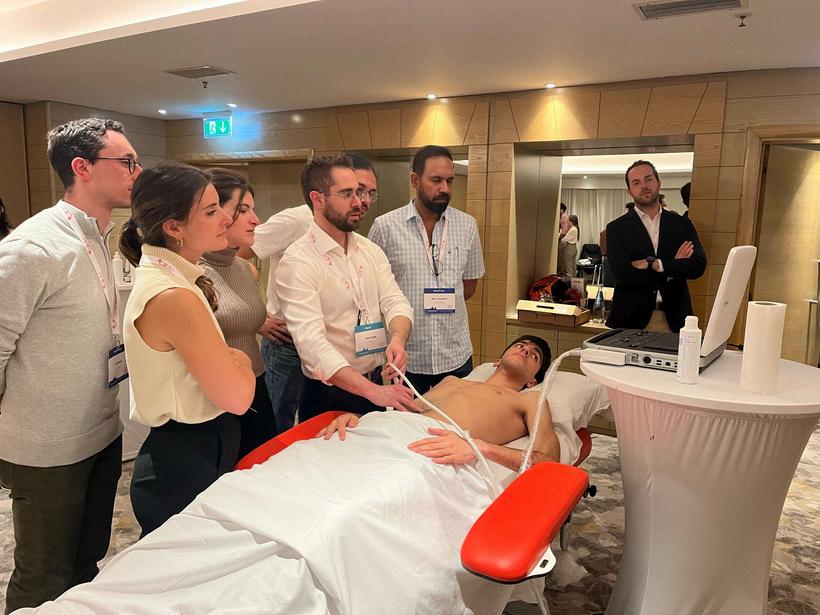
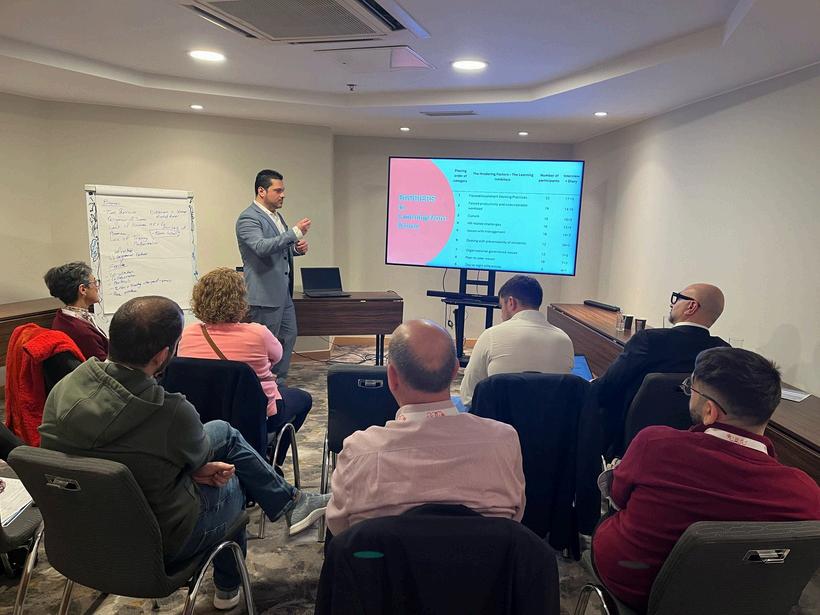
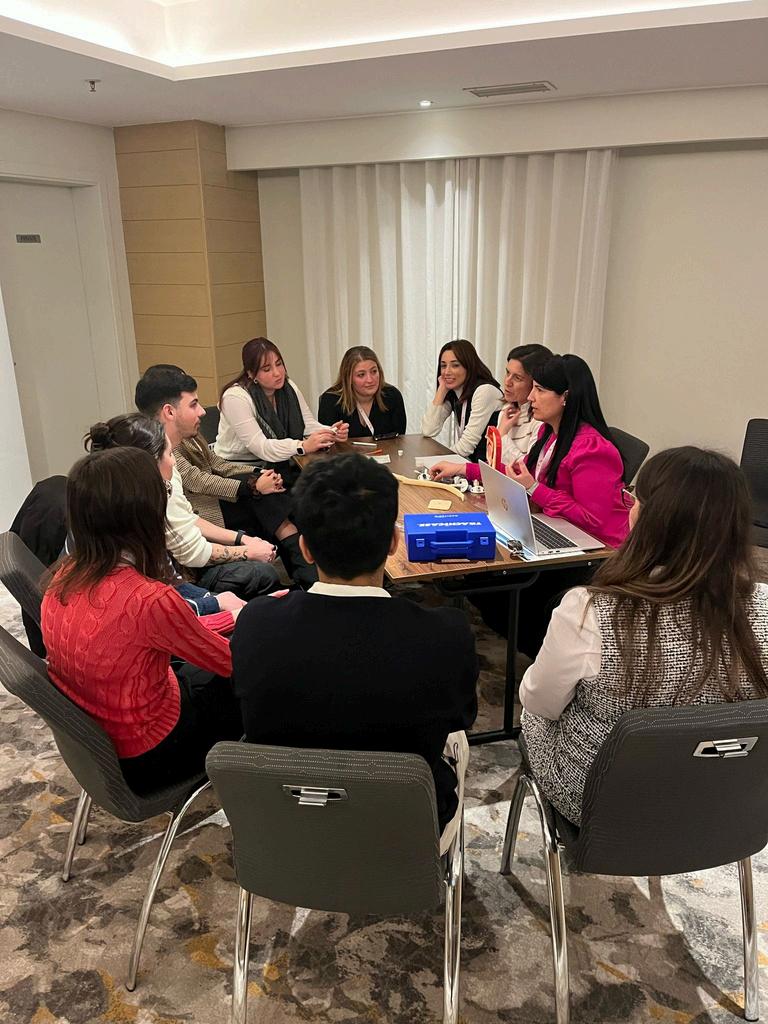
the Introduction to Tracheostomies, Central Venous Access and Vasoactive Drugs
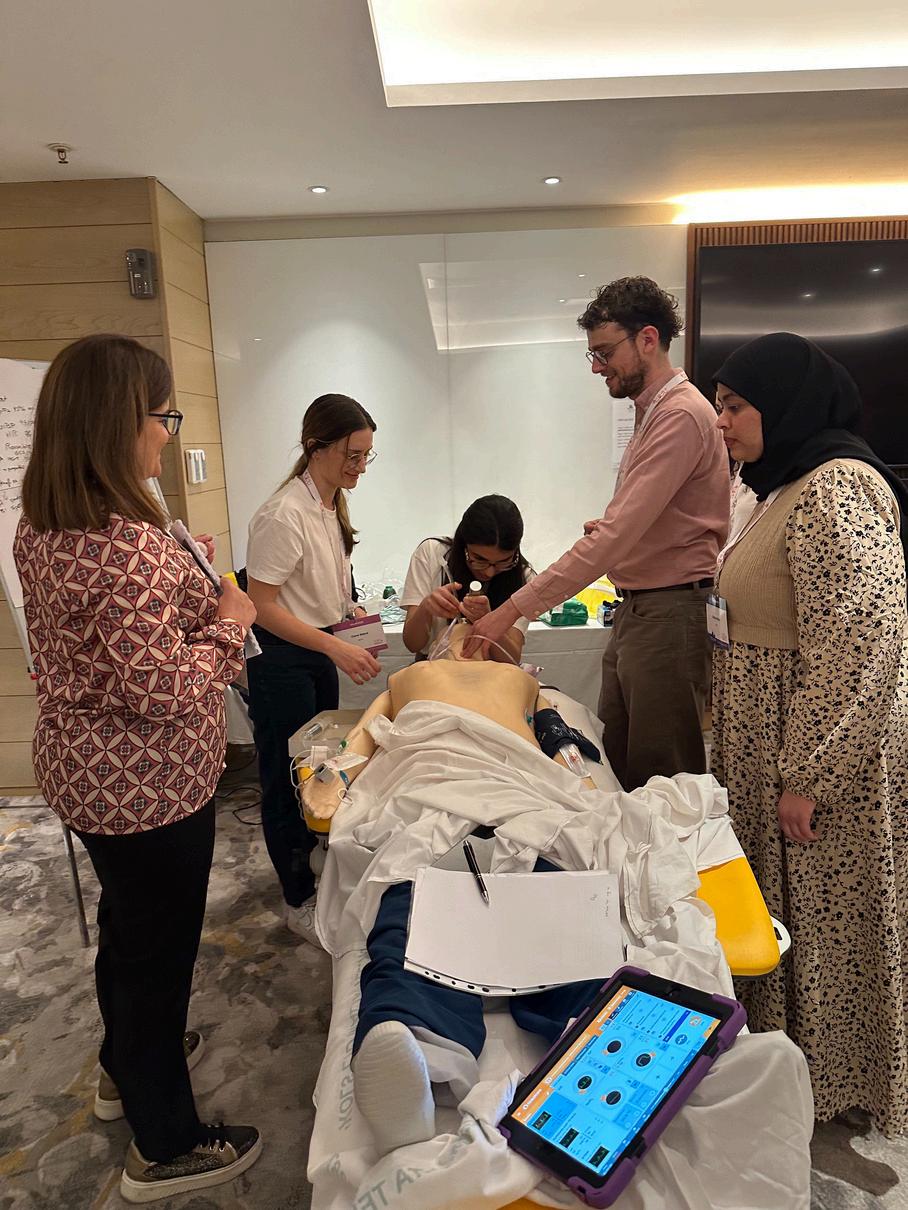
The Opening Ceremony set the tone for the conference, with AAIM Secretary Dr Stephanie Mifsud warmly welcoming delegates, faculty, and esteemed guests. This was followed by brief opening remarks from Dr Kelvin Cortis, Medical Director (Clinical Affairs and Innovation) and Consultant Radiologist (Hepatobiliary Radiology & Interventional Oncology), and Dr Anne Marie Camilleri Podesta, AAIM President. The ceremony concluded with a captivating flute and harp performance by Ms Fiorella Camilleri, Sub-Principal Flutist with the Malta Philharmonic Orchestra (MPO), and Dr Anne Marie Camilleri Podesta, Harpist with the MPO. Their performance featured four enchanting pieces that paid tribute to Malta and its rich cinematographic heritage, including selections from Game of Thrones, Cinema Paradiso, Gladiator, and Libertango—a truly inspiring and culturally resonant start to the event.
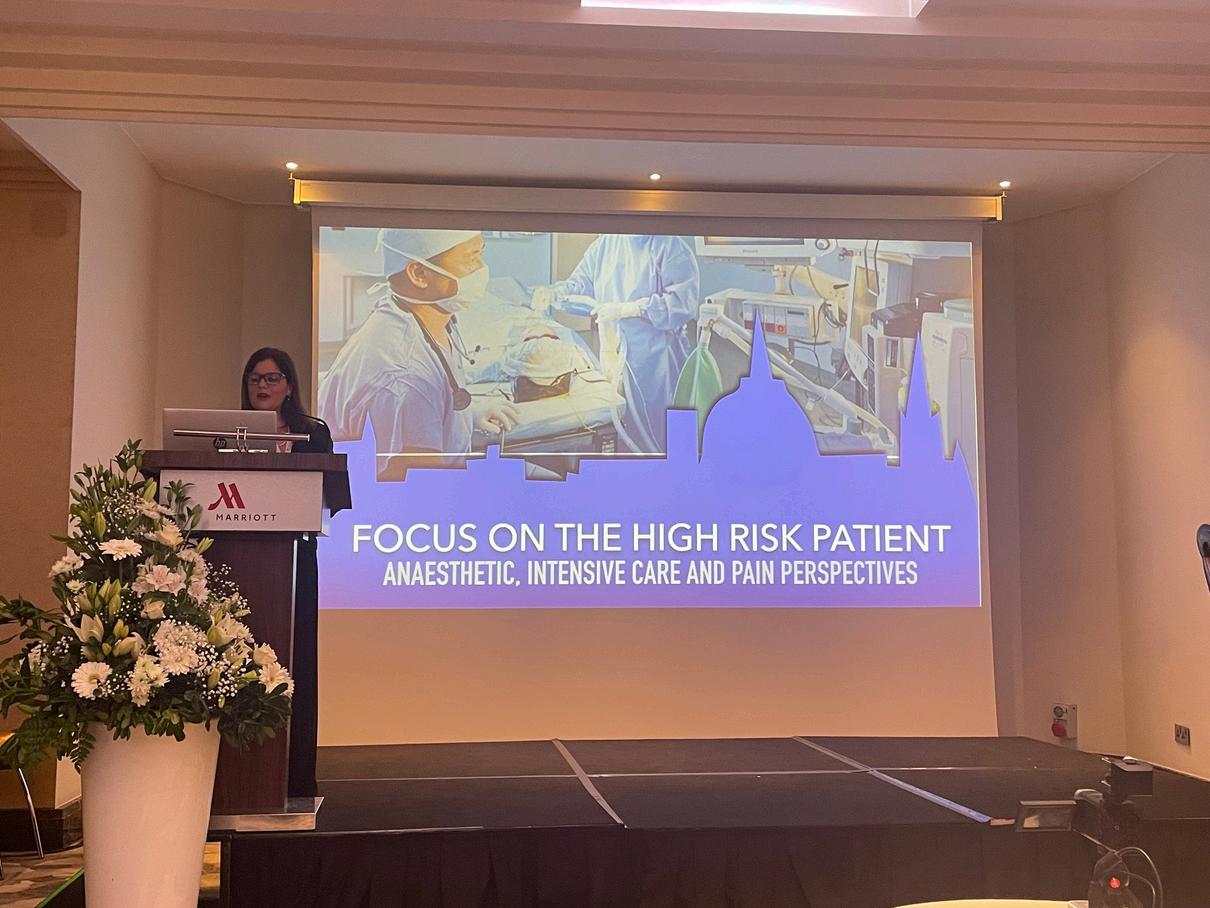
Opening Ceremony –Dr Anne Marie Camilleri Podesta
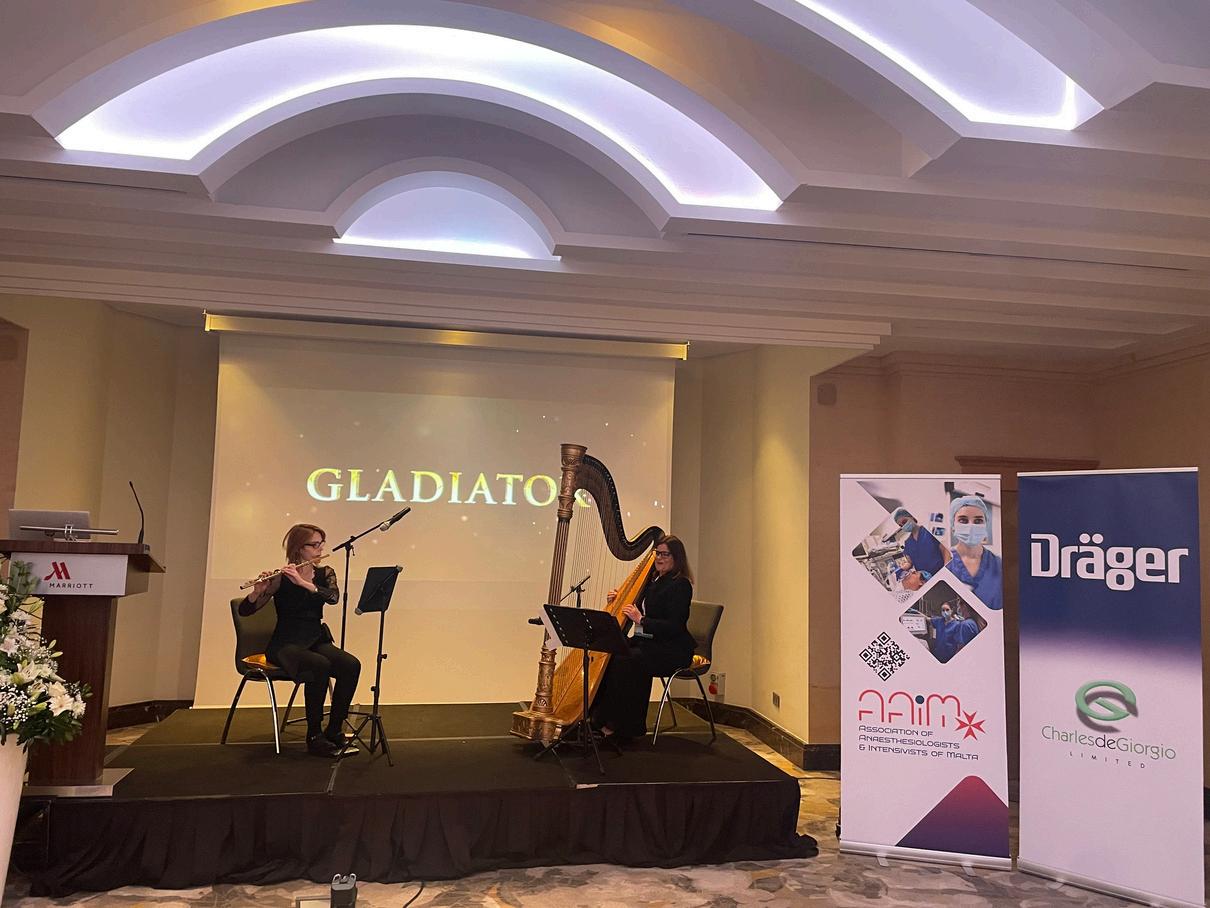
The conference featured a meticulously curated programme spanning two days, designed to address the complex challenges of managing high-risk patient populations. Through a rich blend of keynote lectures, plenary and parallel sessions, delegates explored evidence-based updates across a wide range of topics including intensive care, difficult airway management, elderly and frail patients, upper GI and liver surgery, cardiac anaesthesia, paediatrics, pain management, major vascular surgery, morbid obesity, and non-operating room anaesthesia.
Emerging themes included innovations in assisted ventilation for acute respiratory failure, the role of AI in anaesthesia and critical care, and the critical importance of national reporting systems, patient safety, and non-technical skills in improving outcomes. The scientific content reflected the latest research and real-world applications, making it both relevant and impactful for clinical practice.
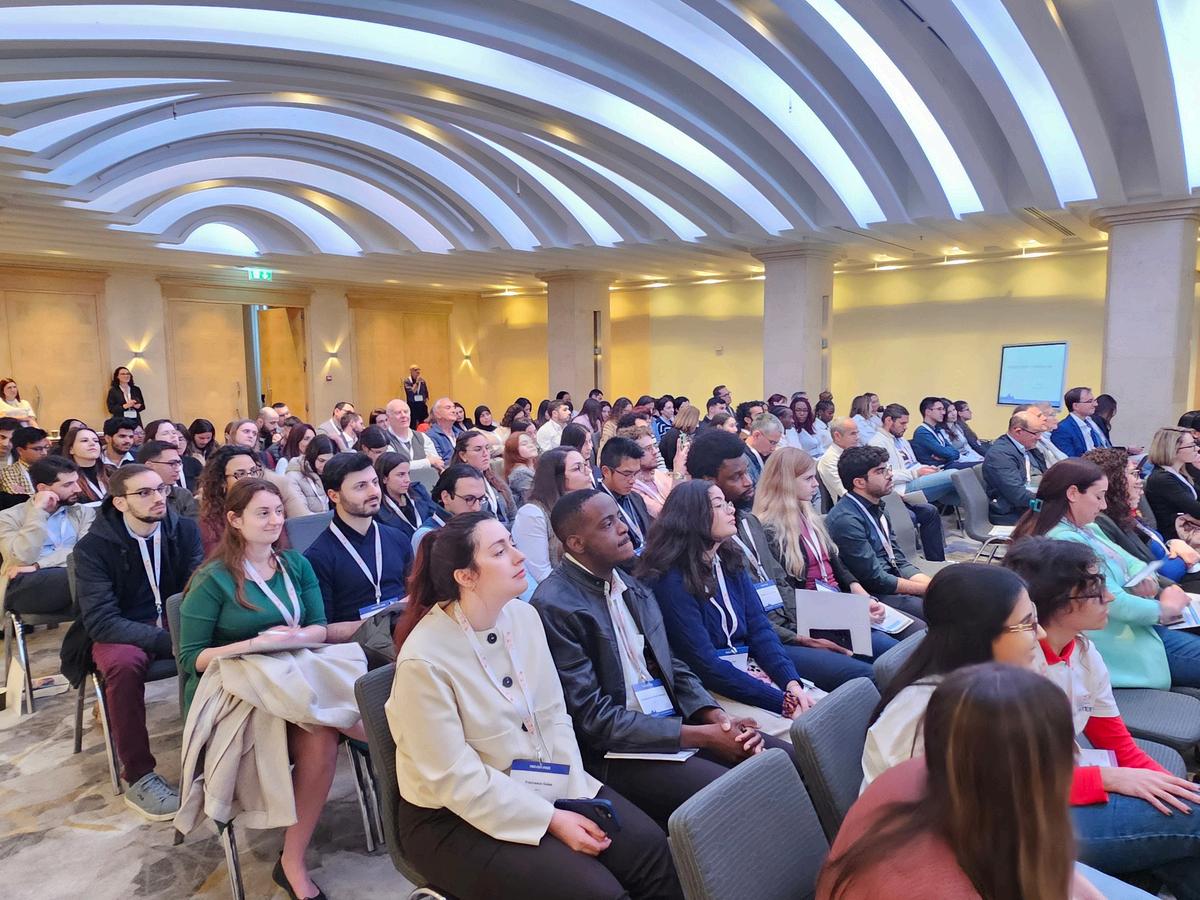
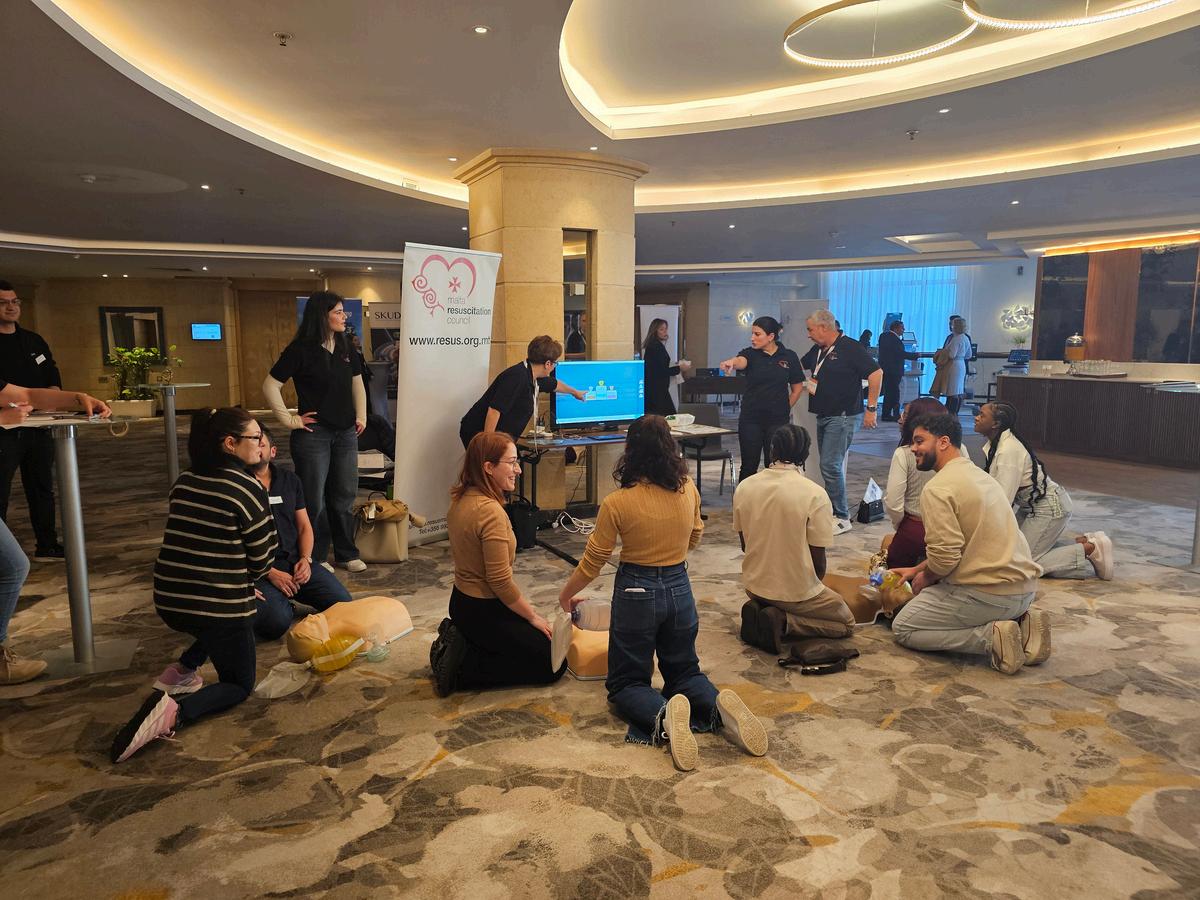
Delegates during the CPR competition organised at the MRC stand
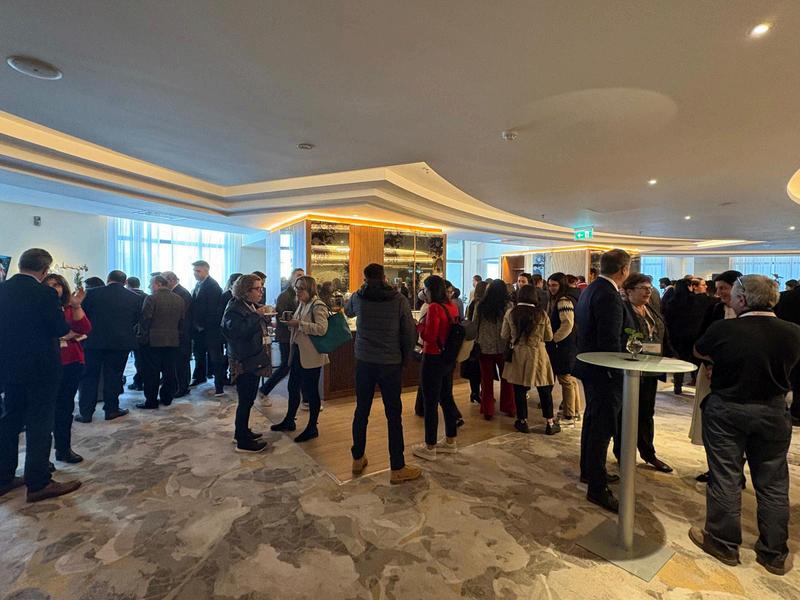
Delegates enjoying the repast during the breaks
The conference also provided valuable opportunities for research dissemination through Super Submission and ePoster presentations
There were 4 Super Submissions. Dr Adrienne Zerafa Simler was awarded First Prize in the Super Submission for her presentation, “The impact of early postoperative oral intake on the length of hospital stay: a meta-analysis” (Camilleri Podestà, Zerafa Simler, Elmawieh, Nagrebetsky, Jammer, Dias Vaz, Ruggeberg, Hammer, Schindler, Bilotta). Key findings included:
1.Early postoperative oral intake reduces hospital stay by a mean of 0.9 days
2 It improves patient outcomes
3 It enhances healthcare sustainability
The study concluded that prolonged postoperative fasting offers no clinical benefit and may hinder recovery and system efficiency.
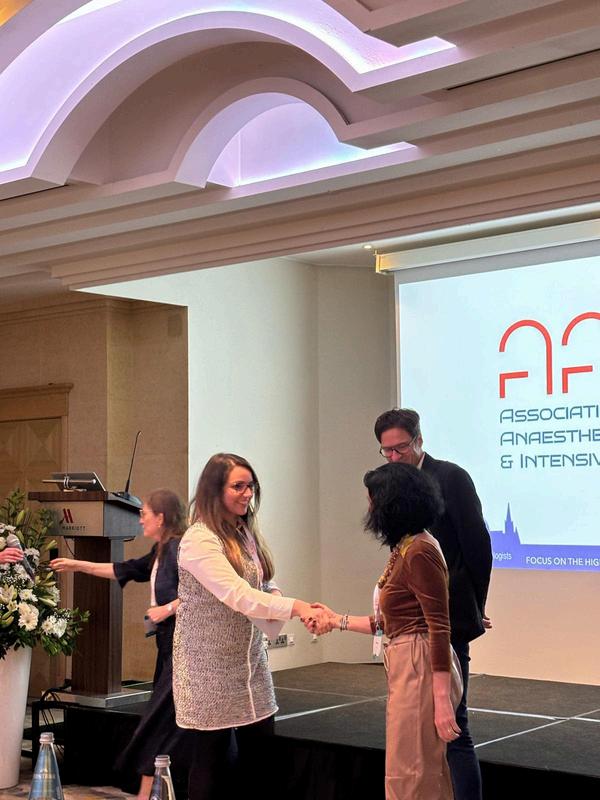
In addition, seven ePoster presentations explored a range of topics—from noise levels in the local ITU, to an audit on peripheral access calls, and various investigations into preoperative fasting practices across different patient populations, including paediatrics. These sessions sparked productive discussions and highlighted the important role of local and international research in improving patient care.
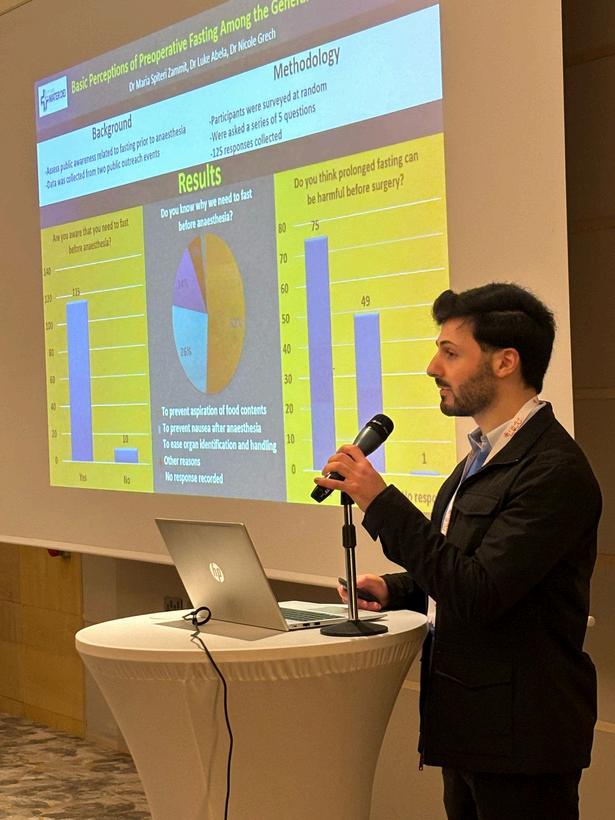
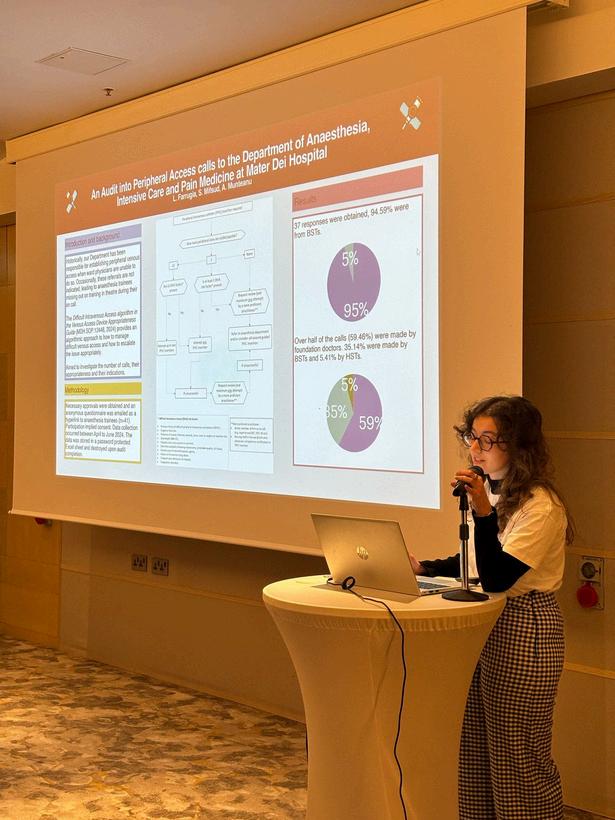
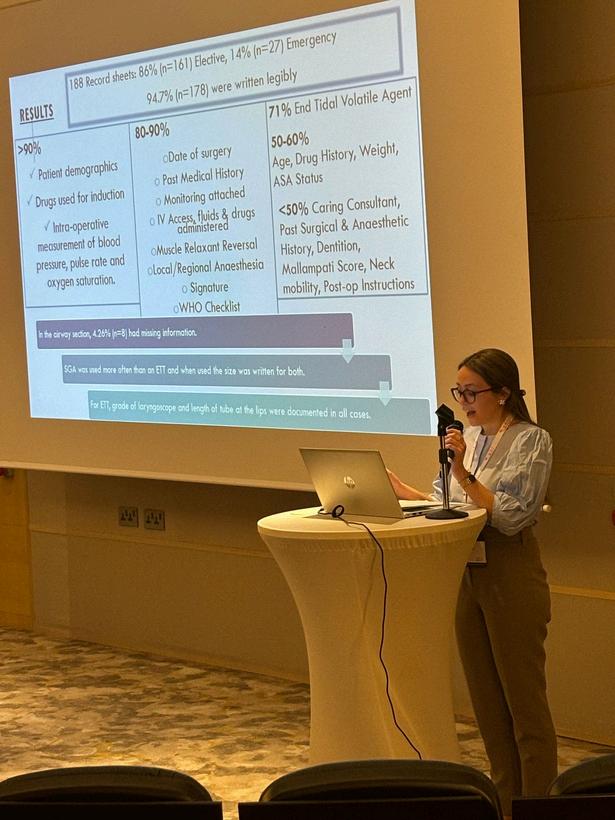
The Closing Ceremony brought the AAIM 2025 Conference to a fitting close. Dr Stephanie Mifsud, AAIM Secretary, expressed heartfelt thanks to all delegates for their active participation and enthusiasm throughout the workshops and sessions. She also extended deep appreciation to the tireless volunteers and AAIM Committee members, whose dedication and months of hard work made the event possible.
Brief closing remarks were also delivered by Dr Petramay Attard Cortis, AAIM Education and Events Coordinator, followed by addresses from Dr Anne Marie Camilleri Podesta, Mr Clarence Pace, Chief Government Medical Officer, and the Hon. Minister Mr. Jo Etienne Abela, Minister for Health and Active Ageing.
Their closing words reflected the spirit of collaboration, commitment to excellence, and the shared goal of advancing patient care that defined the entire conference.
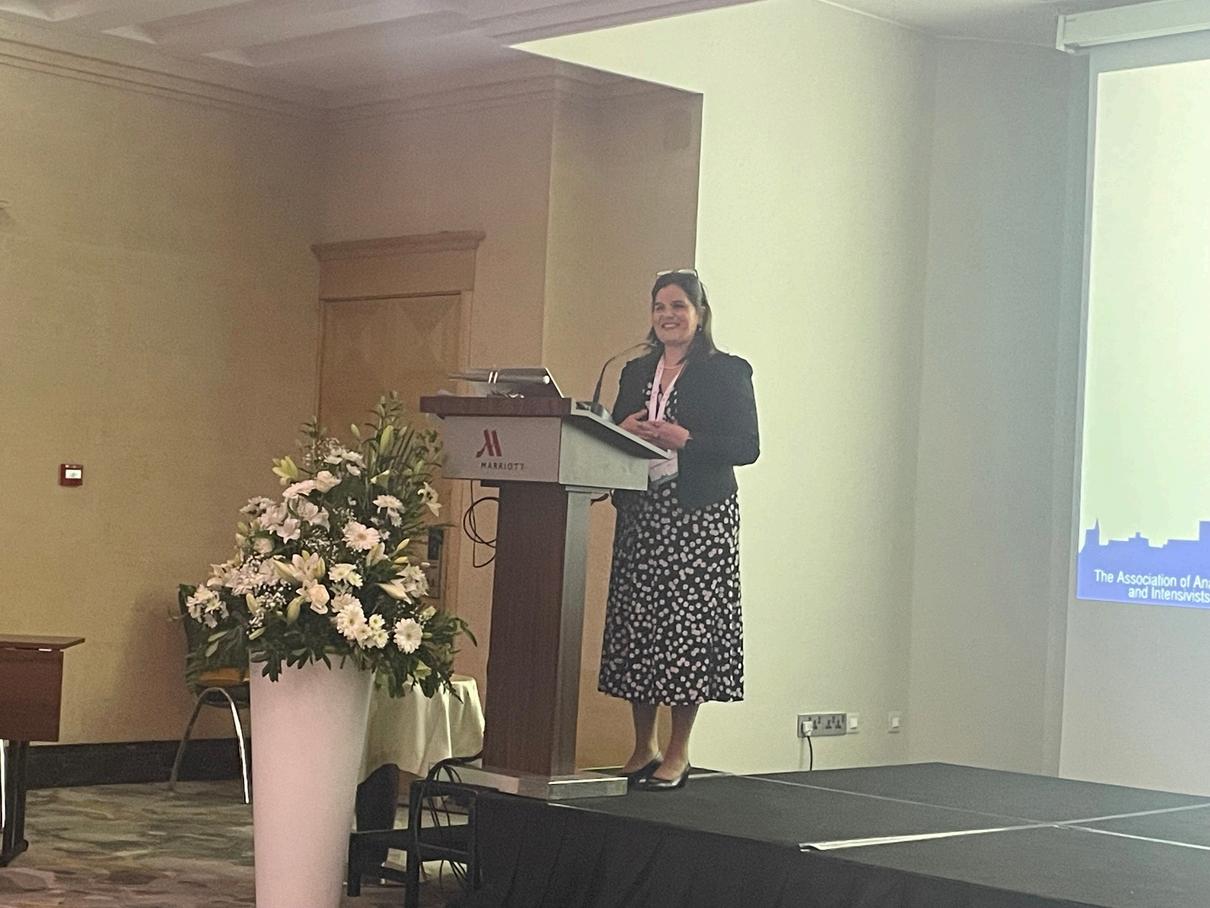
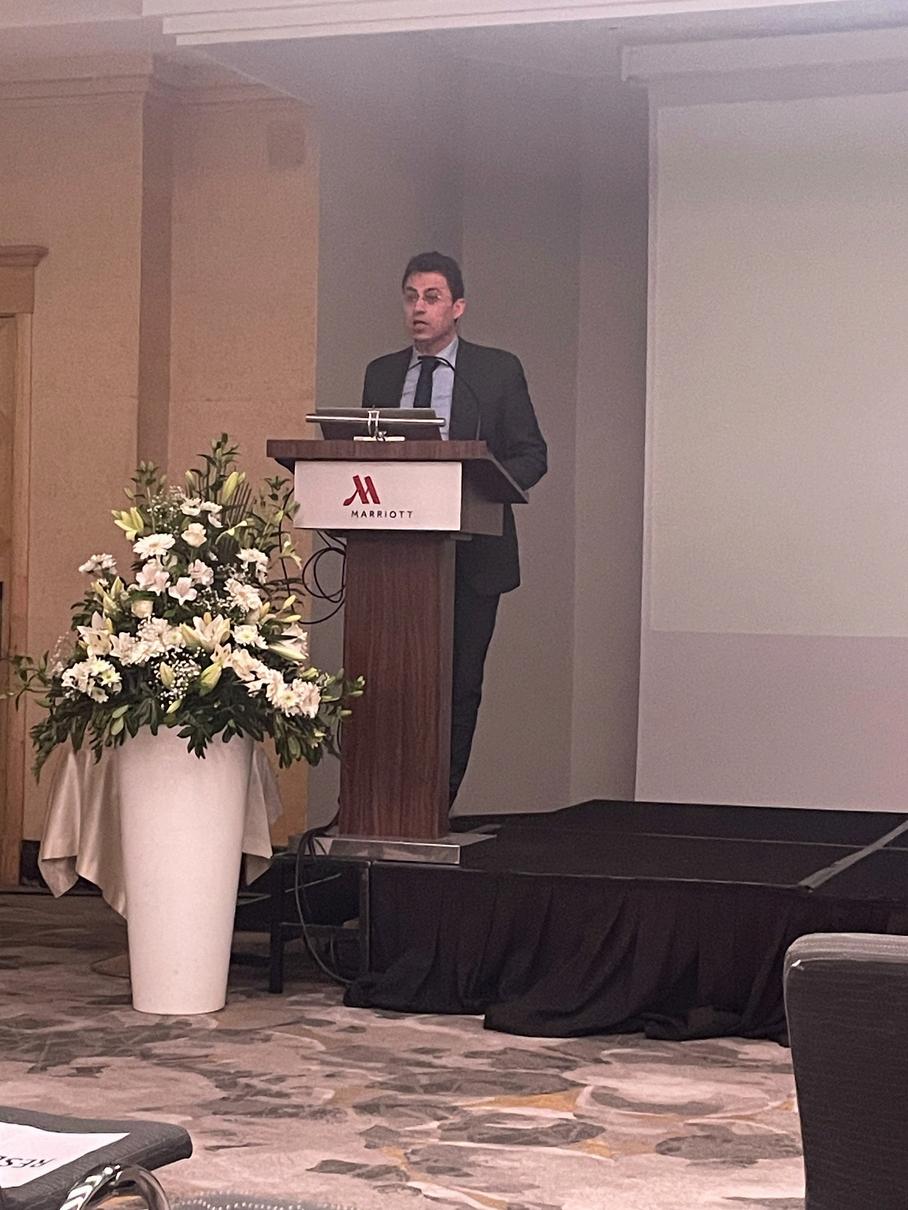
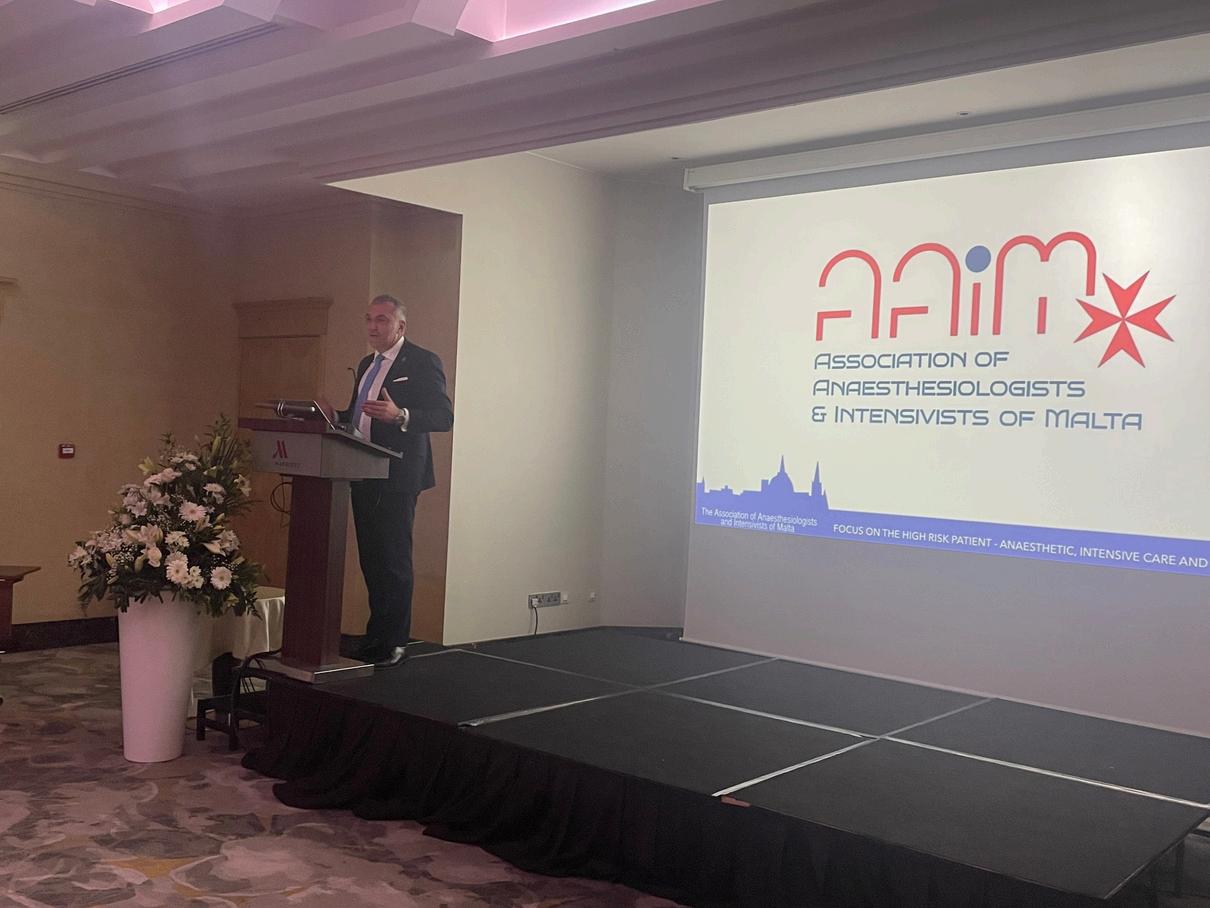
The conference was greatly enriched by the contributions of our esteemed local and international faculty, who led insightful discussions and interactive workshops with exceptional depth and professionalism. We were honoured to welcome several distinguished international speakers, including:
Prof. Idit Matot, President-Elect, European Society of Anaesthesiology and Intensive Care (ESAIC)
Prof. Steffen Rex, President-Elect, European Association of Cardiothoracic Anaesthesiologists (EACTA)
Prof. Federico Bilotta, Immediate Past Chair, ESAIC National Anaesthesiologists Societies Committee (NASC)
Prof. Nuala Lucas, President, Obstetric Anaesthetists’ Association (UK)
Prof. Giacomo Bellani, Head of Anaesthesia and Intensive Care, Santa Chiara Hospital, Trento
Prof. Andrew Lockey, President-Elect, European Resuscitation Council (ERC)
Dr Gérard Gourion, Maxillofacial Surgeon, MBA, PhD
Dr Edgar Brincat, Consultant in Paediatric Intensive Care with international training and leadership in clinical policy
Dr Nick Pace, Retired Consultant Anaesthetist, formerly Clinical Director, Glasgow
Dr Amjid Mohammed, Consultant in Emergency Medicine and Clinical Director across NHS Trusts
From the local front, we were privileged to have the Hon. Mr. Jo Etienne Abela, Minister for Health and Active Ageing, present a comprehensive overview of Upper Gastrointestinal and Liver Surgery, with an emphasis on performance benchmarking and evidence-driven surgical practice. Dr Anne Marie Camilleri Podesta, AAIM President and Chairperson of ESAIC NASC, gave a noteworthy presentation highlighting the latest evidence in preoperative liquid fasting protocols. In total, over 50 local faculty members contributed their expertise across anaesthesiology, intensive care, pain medicine, surgery, radiology, internal medicine, and nursing.
We extend our sincere thanks to all faculty members for their time, dedication, and effort in delivering high-quality, evidence-based, and engaging presentations. Their collaboration with the AAIM Committee was instrumental to the success of the conference. A special thank you also goes to those who led the interactive workshops, which were exceptionally well received and praised for their hands-on value.
A full list of the faculty is available at: https://conference.aaimalta.com/category/faculty/
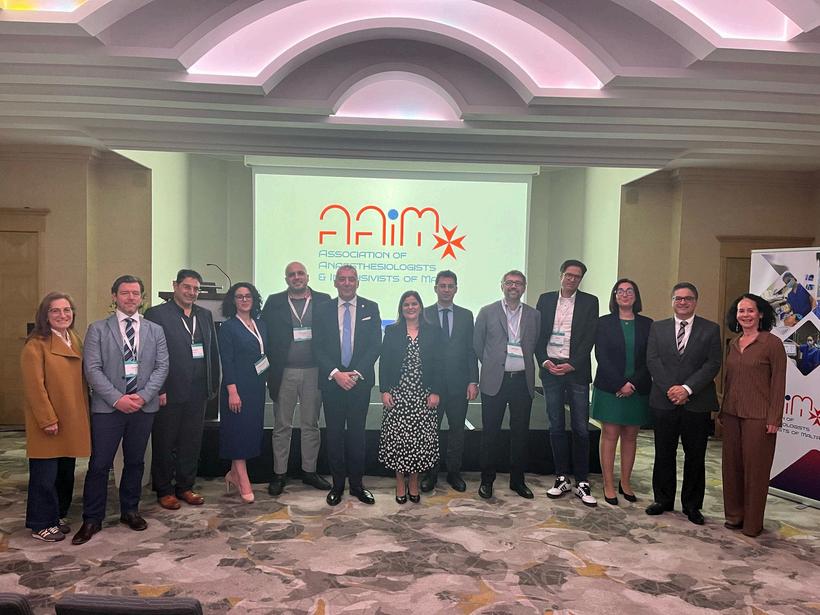
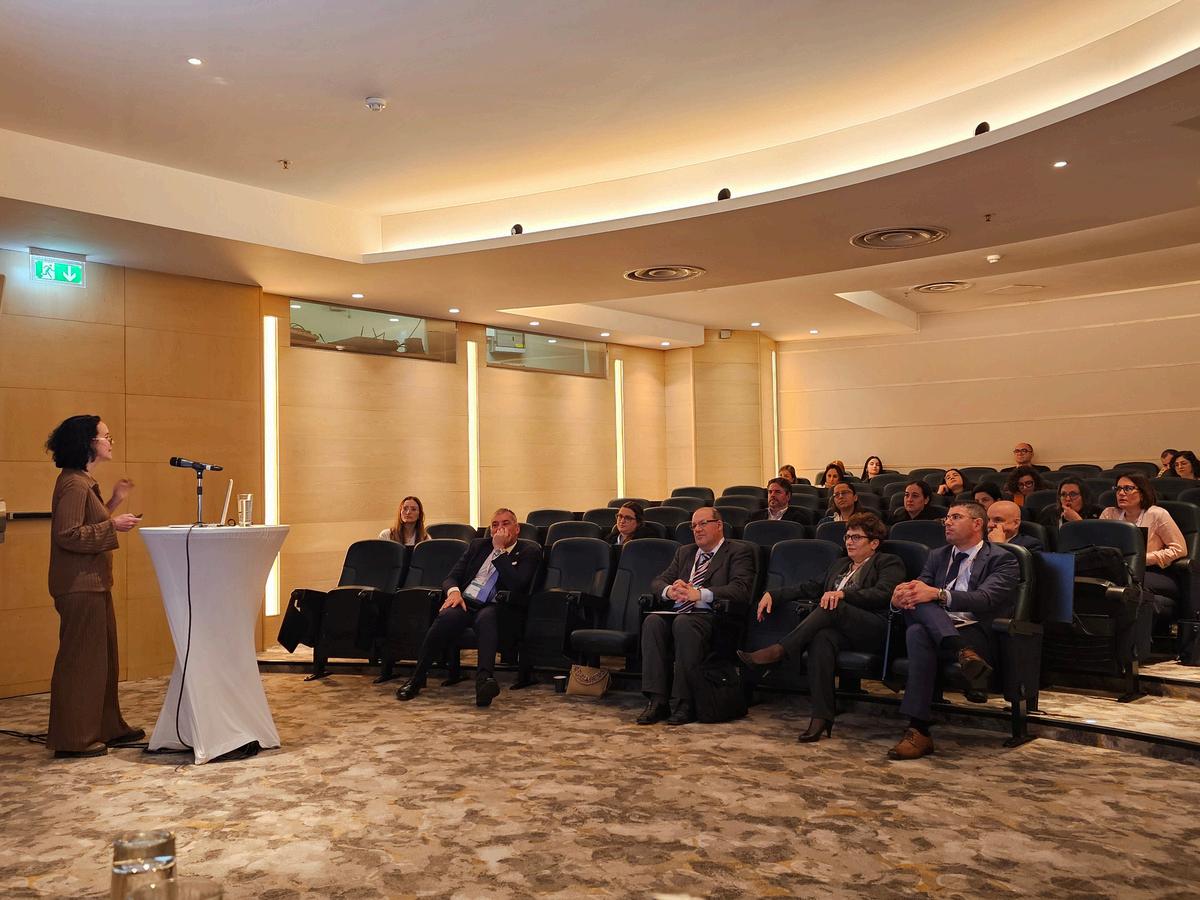
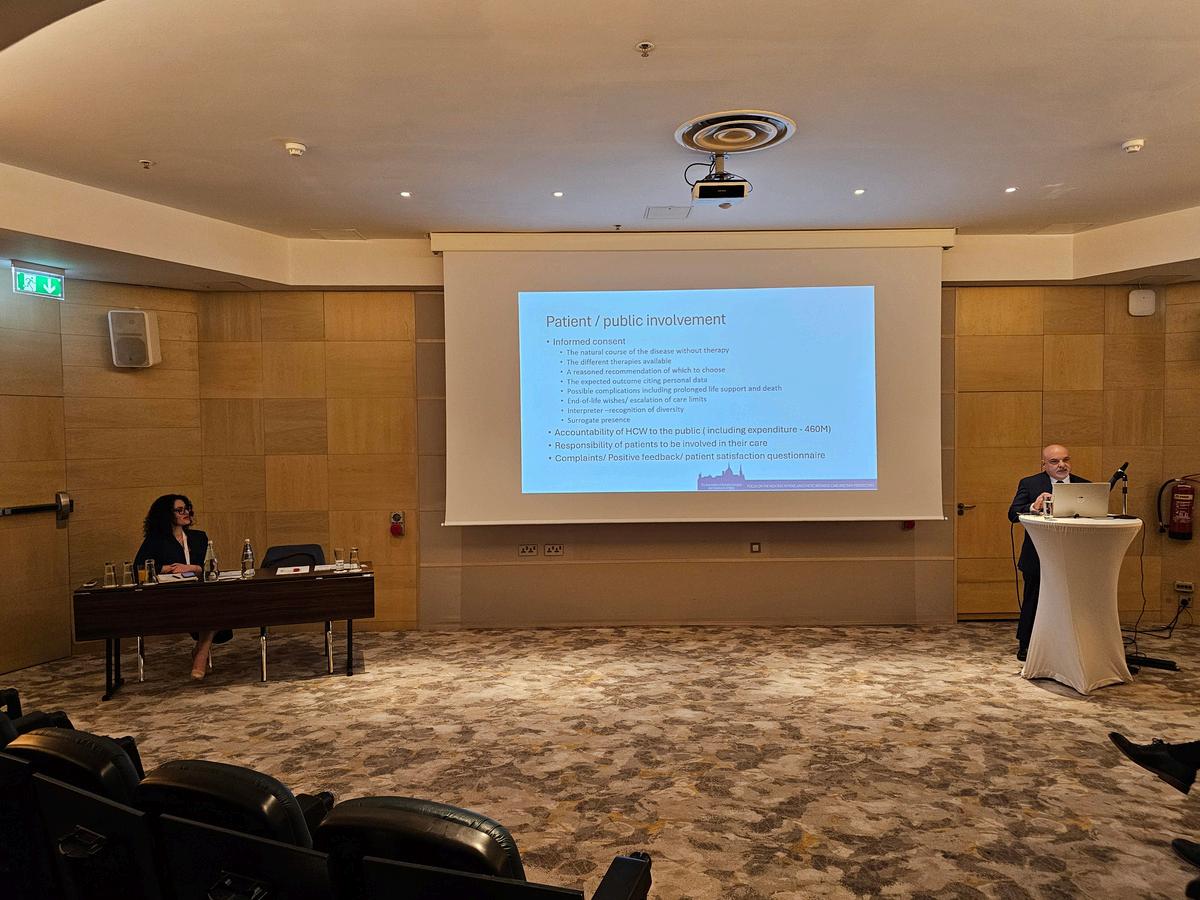
Mr. J. Debono Medical Director Medicolegal Affairs, Governance and Appraisal presenting his lecture on The Importance of Governance in the Care of High-Risk Patients
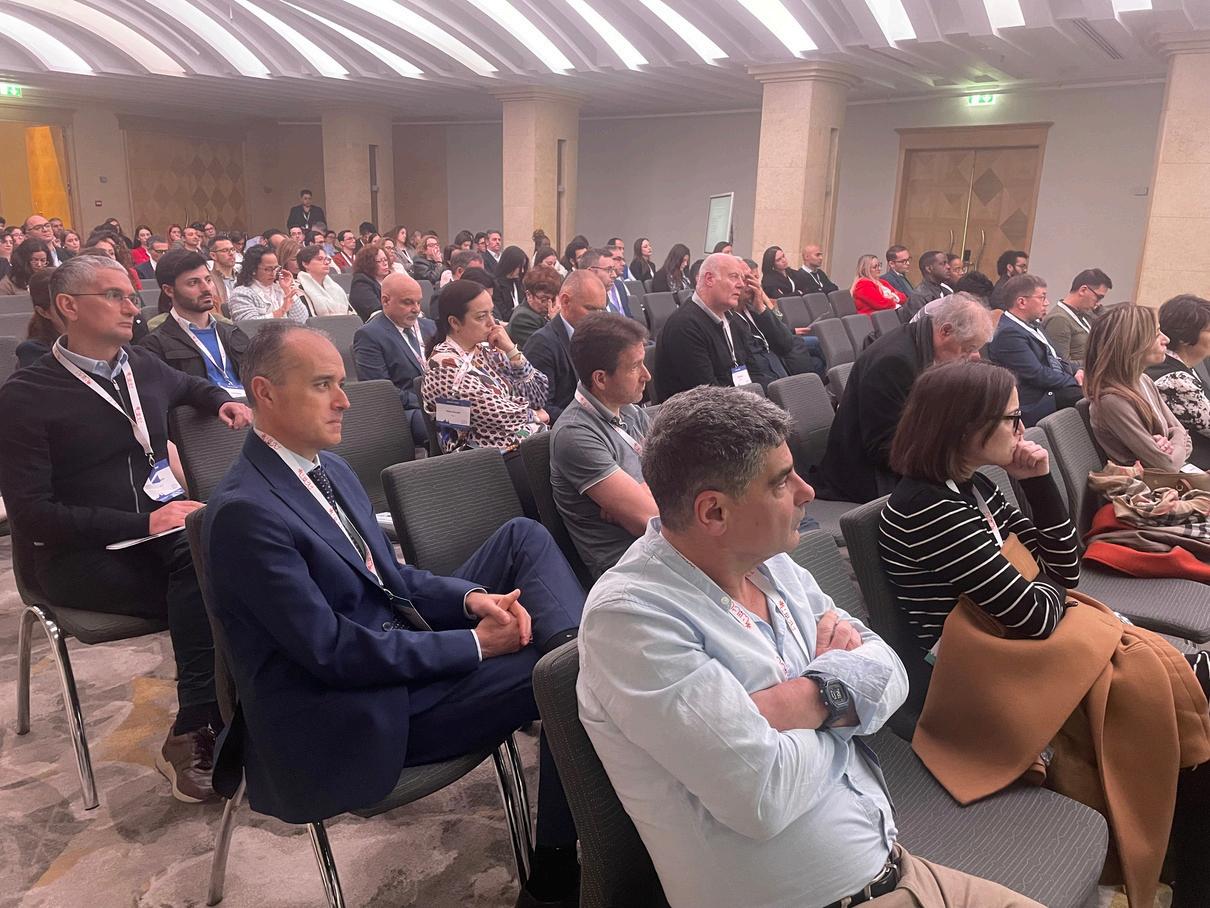
Dr Melissa Sammut MD , MRCSI, MSc (Cardiff)
Being involved in the organisation of the AAIM conference - The High-Risk Patient, which took part in February this year, was a great opportunity.
Preparing for the conference took time and frequent meetings with the AAIM members and other volunteers, in order to update each other on how the whole of the preparation was progressing, as well as what further tasks were required. My involvement mainly centred around maintaining and keeping participant information up to date, an aspect of the conference logistics which put my organisational skills to the test and required much attention to detail. However, this task was particularly enjoyable for me as it allowed me to use these skills in a different manner than I would in my usual day-to-day work.
Despite all the work that was required and how long the preparation took, the end was a reward in itself. The conference was a success, with many participants coming up to us both on the day and weeks after to inform us on how well organised everything was and how much they enjoyed the conference itself. Furthermore, working with so many different people and making new connections was another bonus, and I would definitely look forward to another similar experience.
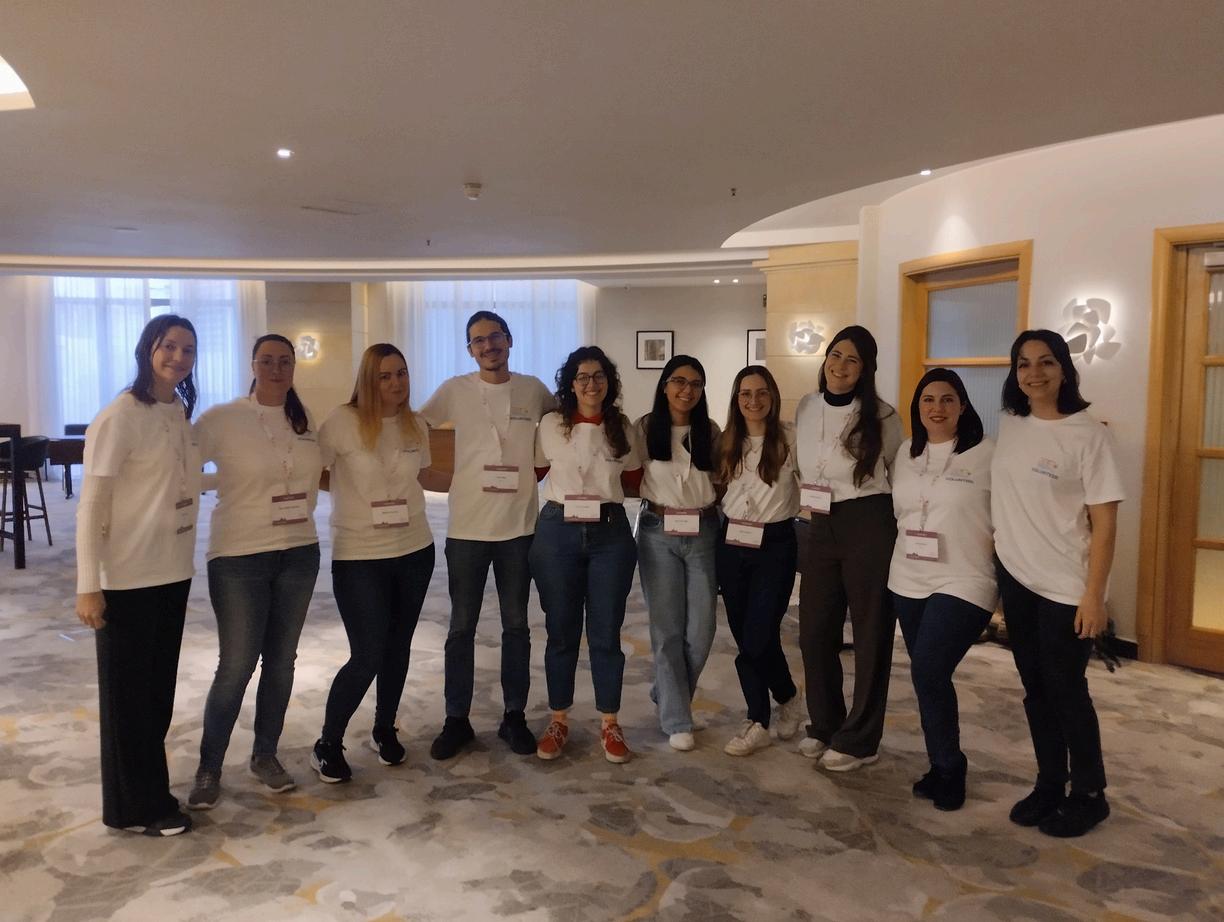
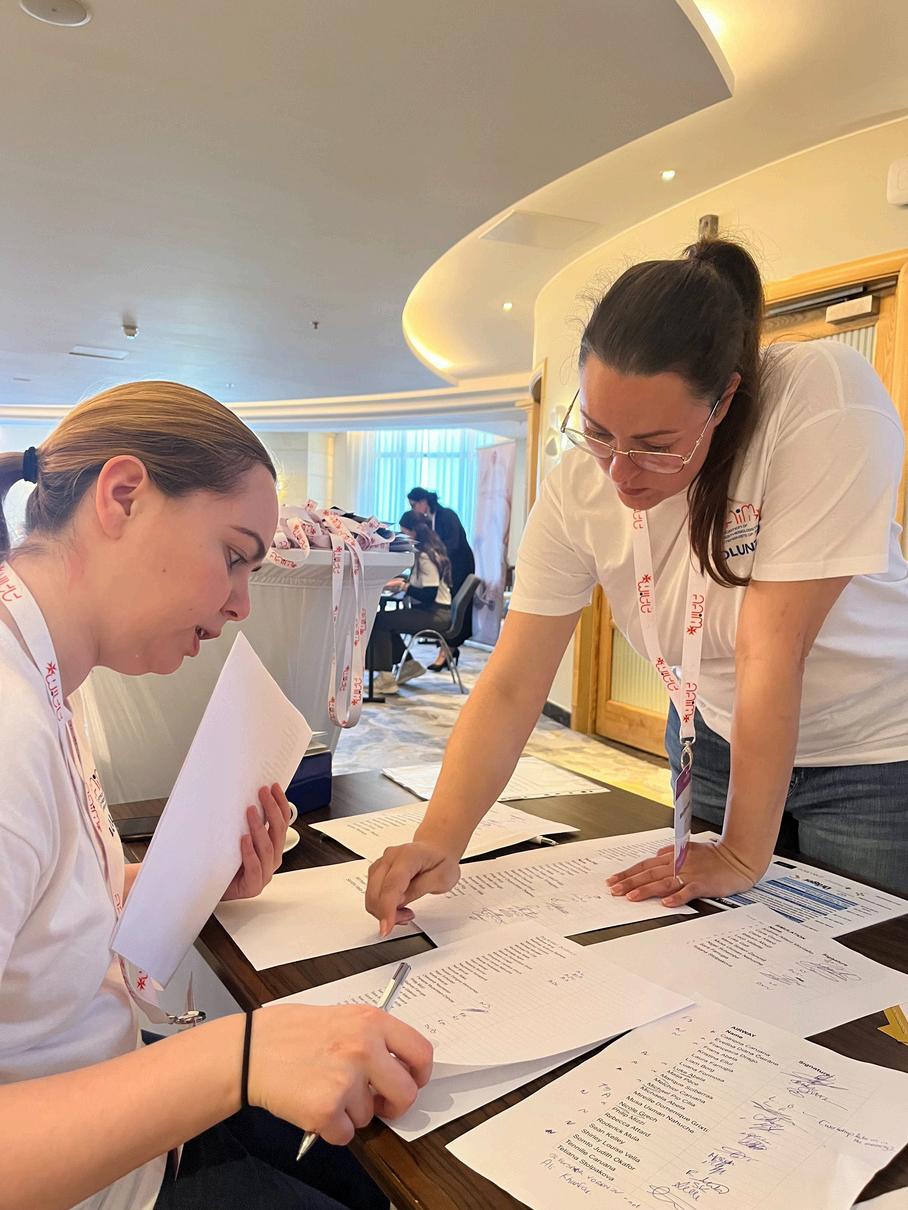
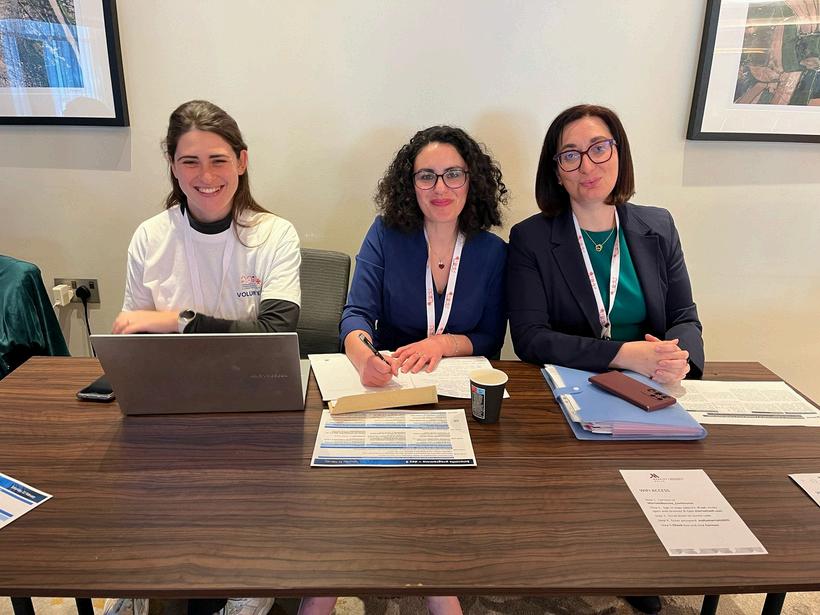
The AAIM extends its sincere appreciation to the Honourable Minister Mr. Jo Etienne Abela, Minister for Health and Active Ageing of the Republic of Malta, as well as to the Mater Dei Hospital medical administration for their invaluable support in making this event possible. We are also deeply grateful to the World Federation of Societies of Anaesthesiologists (WFSA) and the European Society of Anaesthesiology and Intensive Care (ESAIC) for their official endorsement of our conference.
A special thank you goes to our Platinum Sponsors:
Malta Resuscitation Council, Charles De Giorgio Ltd, the Malta Tourism Authority (MTA), and the Malta Postgraduate Medical Training Centre.
We also acknowledge and appreciate the generous support of our Gold Sponsors: Drugsales Ltd, Medina Healthcare Ltd, St. James Hospital Malta, Associated Equipment Ltd, Cherubino Ltd, Menarini, and Vathin Medical.

Finally, a heartfelt thank you to all our members, colleagues, allied health professionals and international delegates who attended the workshops and conference. Your presence, participation, and continued support are what make the work of AAIM possible and meaningful.
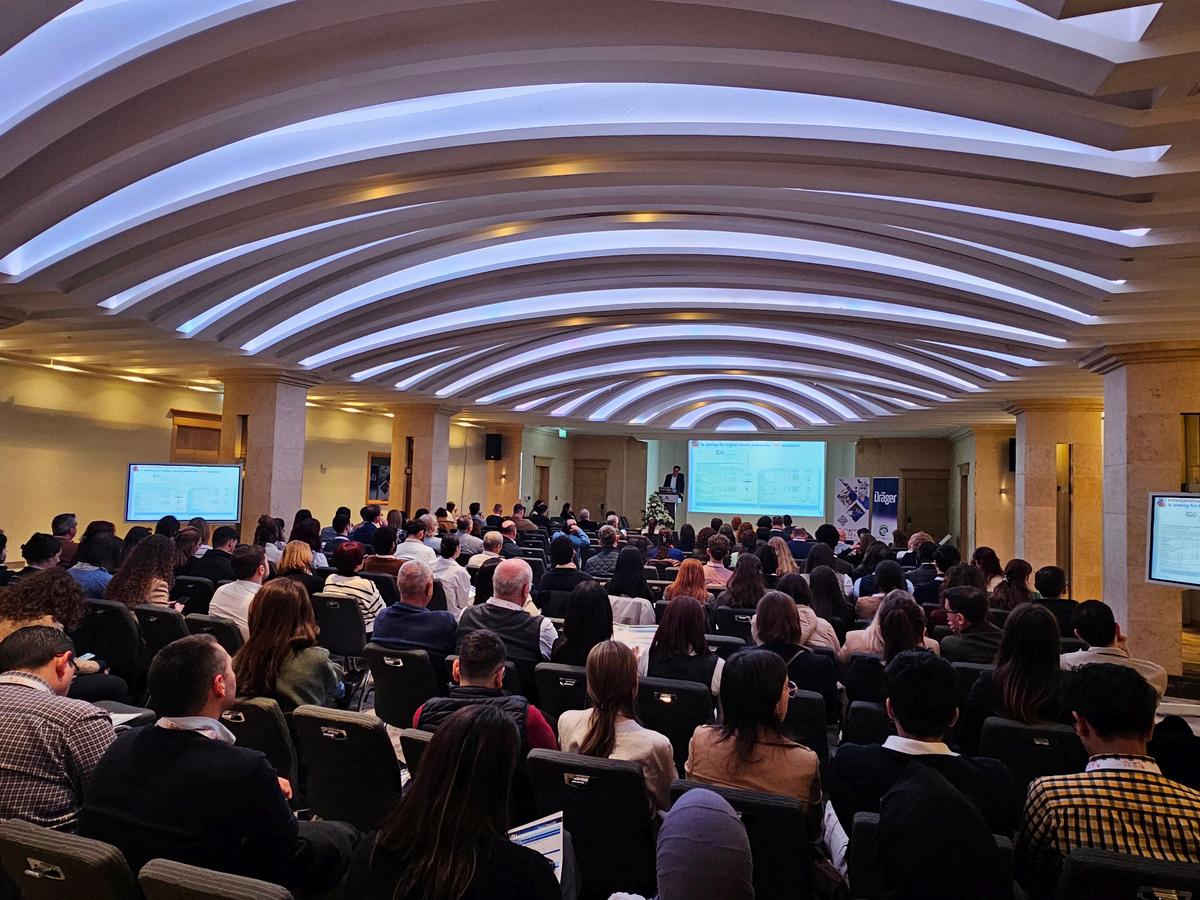
THANK YOU for attending the AAIM Conference!
Royal College of Physicians XXXVIIth
Edinburgh Anaesthesia Festival
European Society of Regional Anaesthesia (ESRA)
42nd Annual Congress
20-22 August 2025, Edinburgh, Scotland https://eafest org/joom2/
10-13 September 2025, Oslo, Norway
https://esraeurope org/meeting/42 nd-esra-annual-congress/
The Association of Anaesthetists Annual Congress 2025
17-19 September 2025, Aberdeen, Scotland
https://anaesthetists org/Home/Ed ucation-events/Annual-Congress
NYSORA Pain Summit 2025
20-21 September 2025, Leuven, Belgium
https://www.nysora.com/painsummit/
ESPA European Congress for Paediatric
Anaesthesiology 2025
2-4 October 2025, Berlin, Germany
https://www espacongress com/
Anaesthesiology 2025
10-14 October 2025, San Antonio, Texas US
https://www asahq org/annualmee ting
ERC Congress, Resuscitation 2025
23rd - 25th October 2025, Rotterdam, The Netherlands
https://www resuscitation eu/
OAA Three Day Course in Obstetric Anaesthesia
3rd - 5th November 2025, London, UK
https://www.oaaanaes.ac.uk/events/overview
SEPTEMBER

DR ANNE MARIE CAMILLERI PODESTA
Elected as ESAIC NASC
Chairperson & being awarded the FESAIC - Fellow of the European Anaesthesiology and Intensive Care
DR JULIA AQUILINA, DR NICOLE ATTARD, DR GAIVIN JAMES BUHAGIAR, DR KRISTINA DUCA, DR REBECCA GALEA, DR MARTINA GERADA, DR NOELLA MUSCAT, DR NIGEL SCHEMBRI
Successfully obtained their EDAIC Part 2 in 2025
All trainees who have successfully progressed to their next year of training
For more information, you can reach them on: 25456900/1 or email psychologyreferal.mdh@gov.mt or paul.sciberras@gov.mt
Alternatively, you can find more information on the MDH Portal at https://health.intra.gov.mt/mdh/psychology/SitePages/Home.aspx or follow their Facebook page on https://www.facebook.com/psychologymaterdei/.
F’mumenti ta’ diffikulta', uri kuraġġ u fittex l-għajnuna! In times of difficulty, take the step and reach out!
This is a publication brought to you by the Association of Anaesthesiologists & Intensivists of Malta (AAIM)
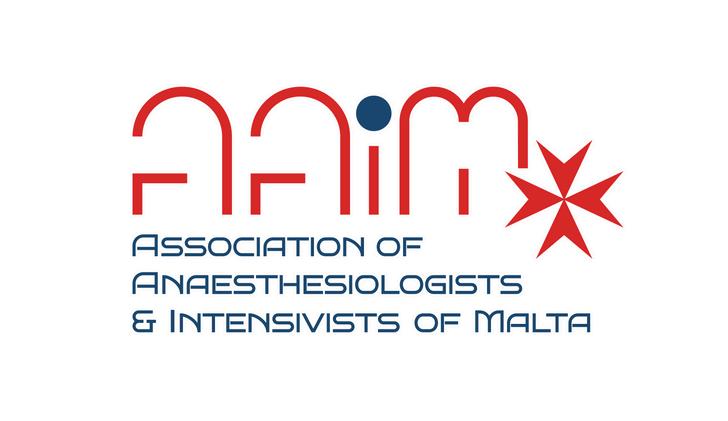
Editor: Dr Stephanie Mifsud
Editorial Assistant & Design: Dr Martina Gerada
Writers: Dr Petramay Attard Cortis, Dr Anne Marie Camilleri Podesta, Dr Kristina Ellul, Dr Martina Gerada, Dr Stephanie Mifsud, Dr Melissa Sammut, Dr Velitchka Schembri Agius, Dr Stephen Sciberras, Dr Maria Spiteri Zammit, Dr Yanika Stafrace, Dr Adrienne Zerafa Simler